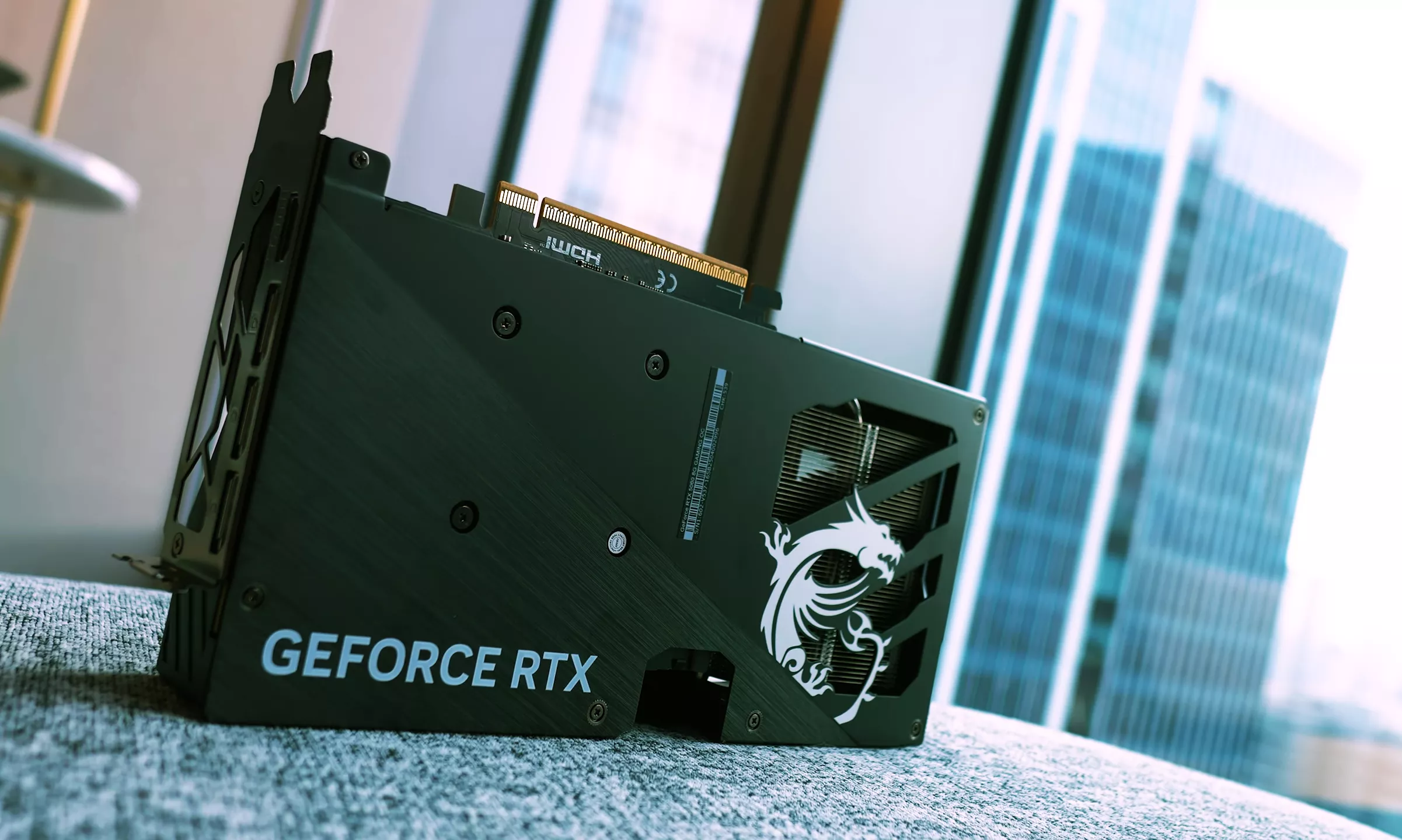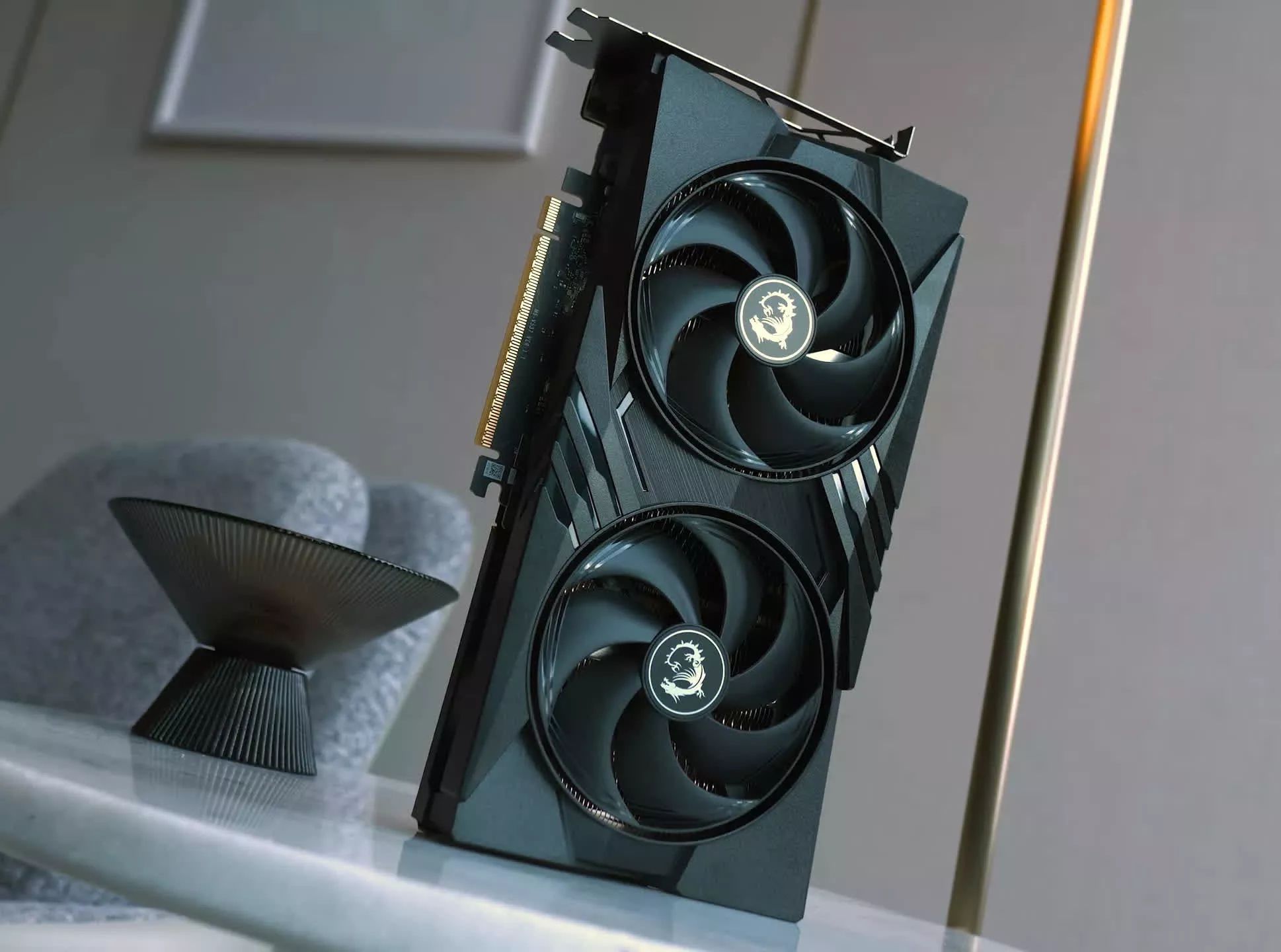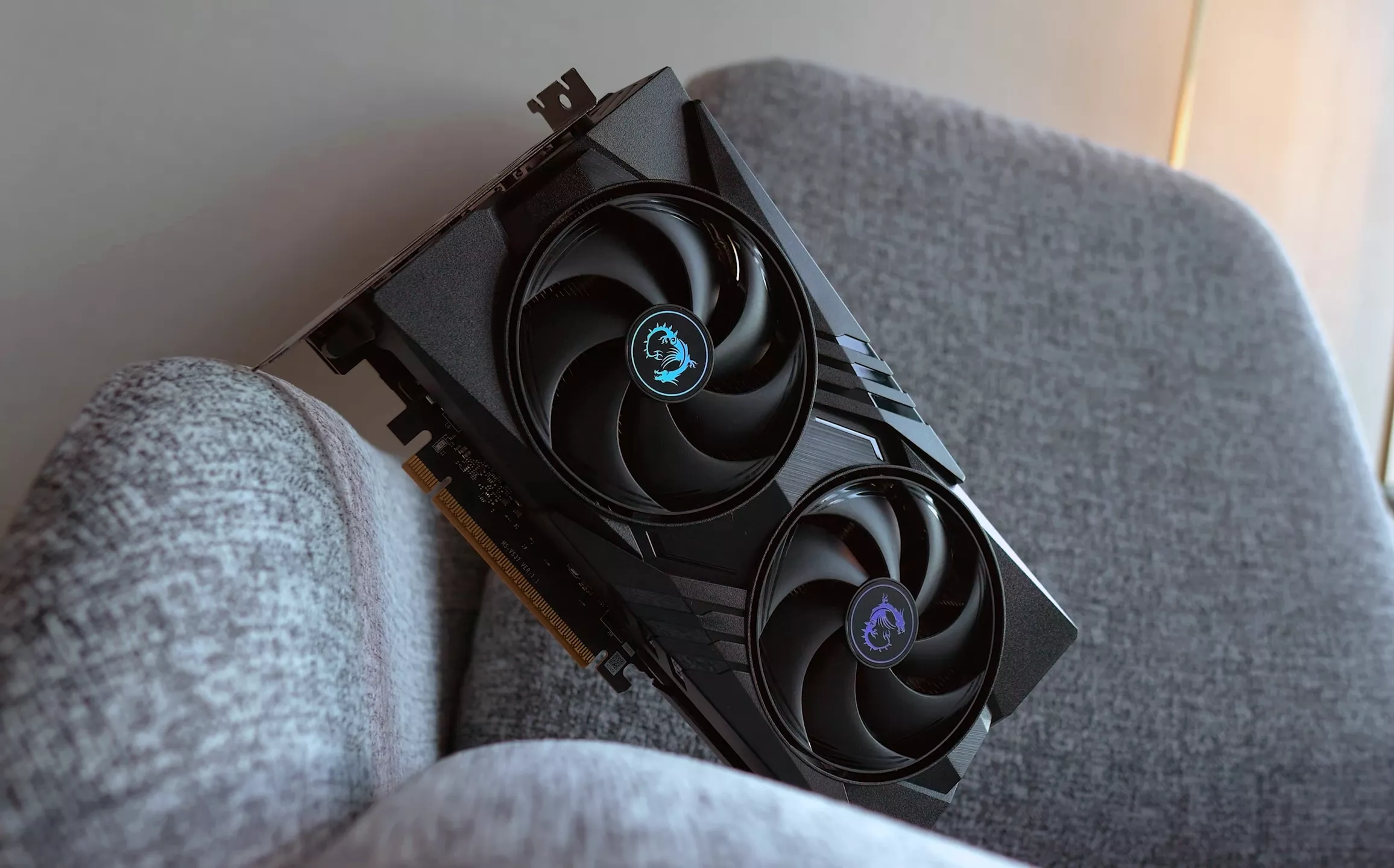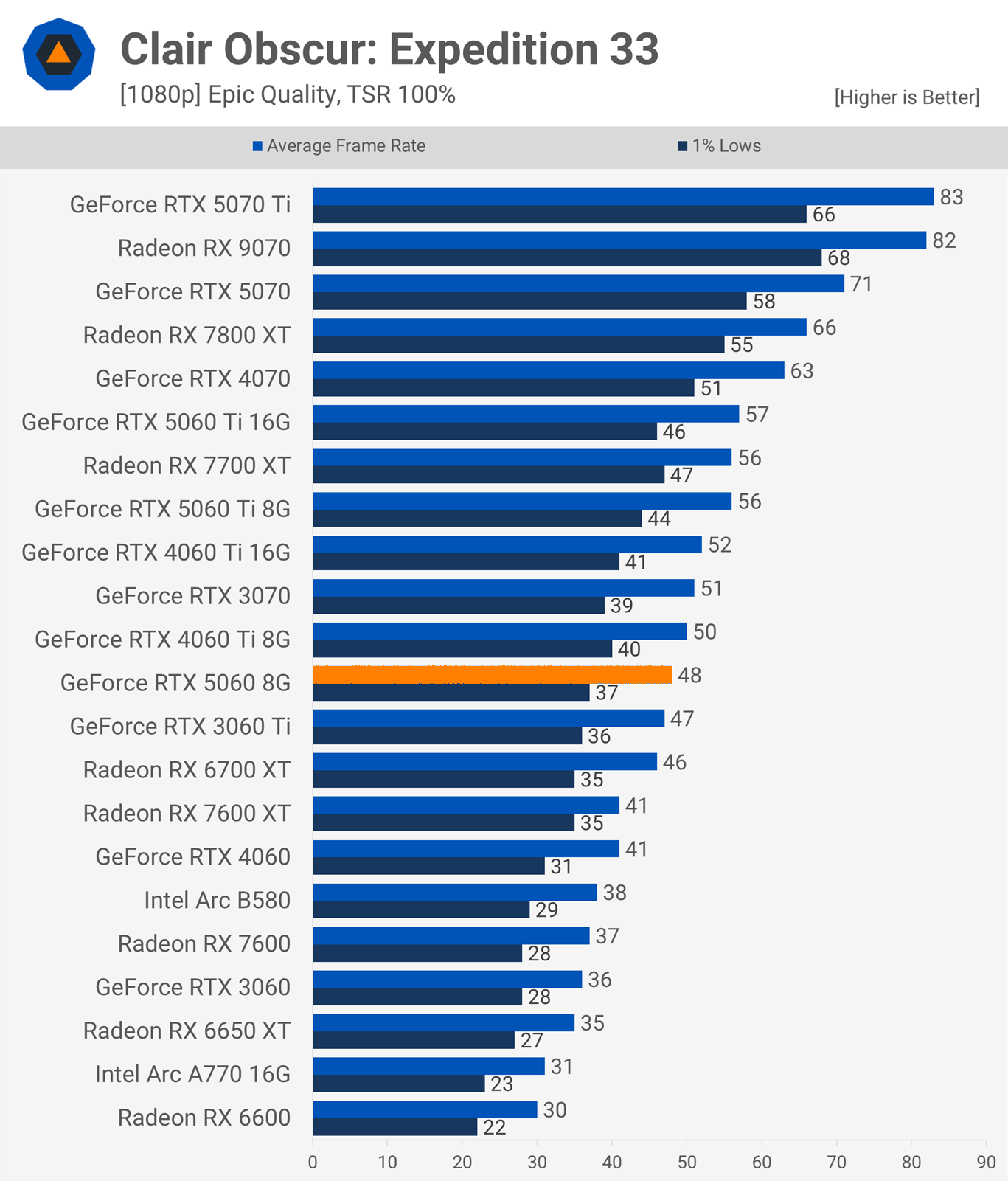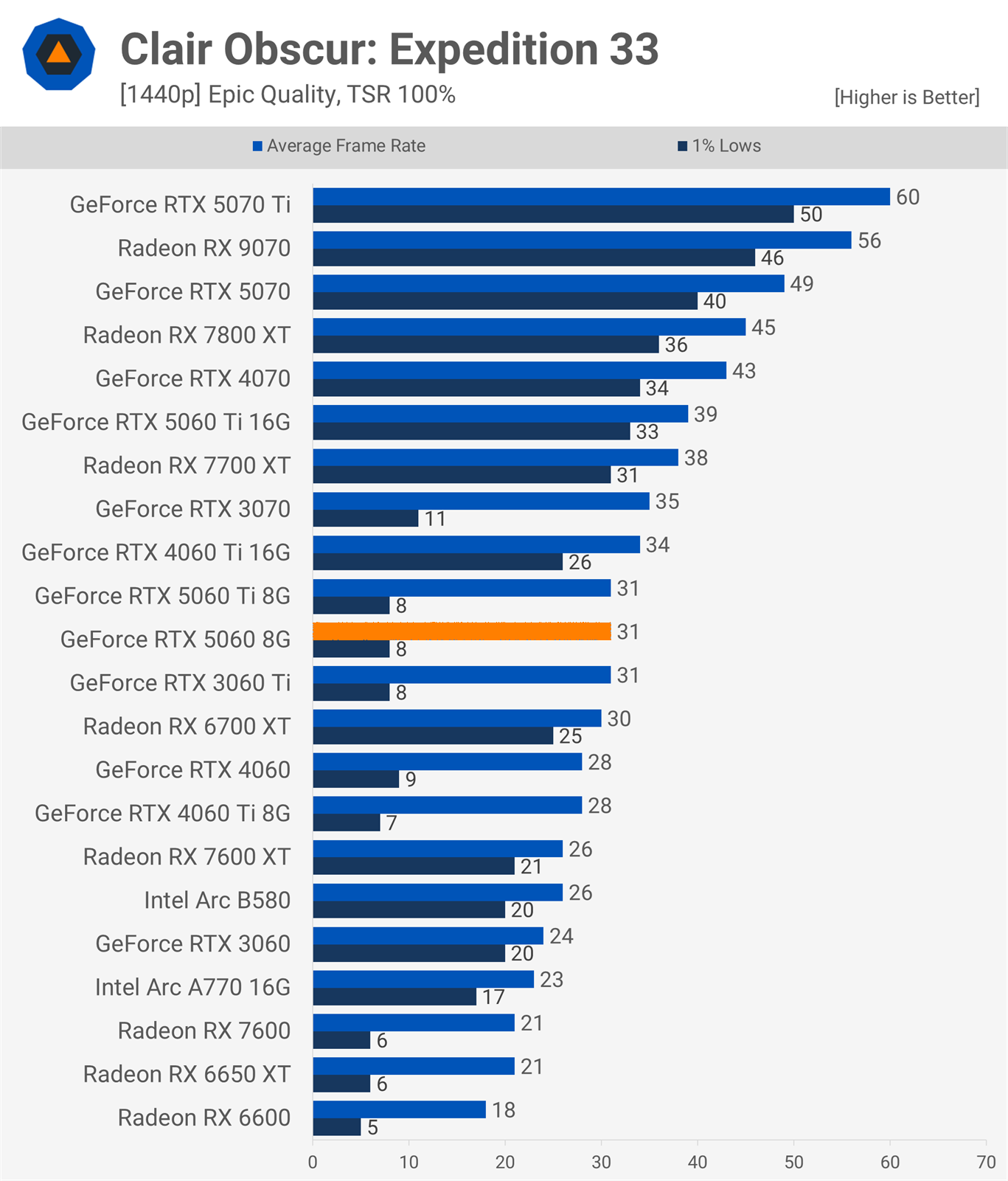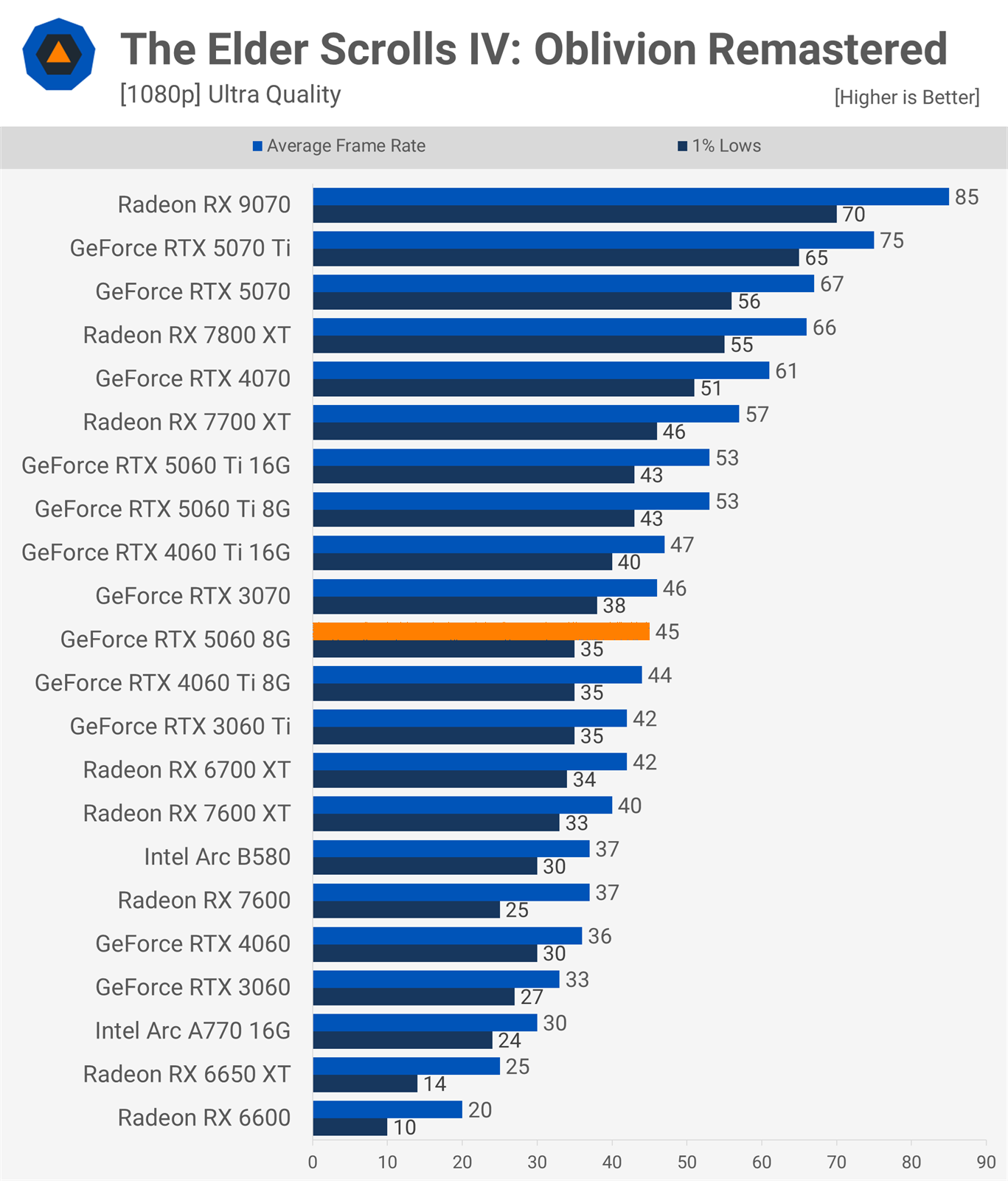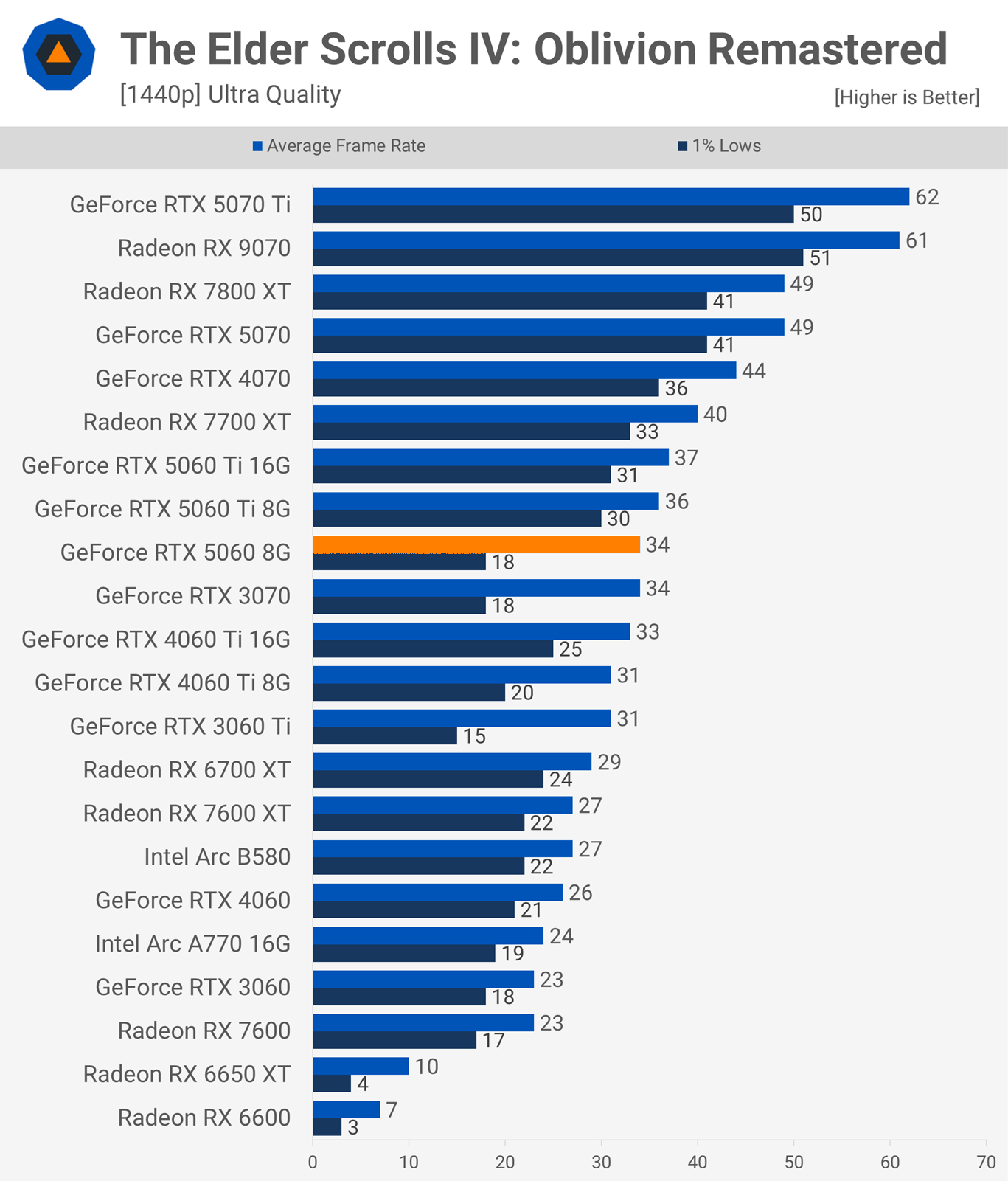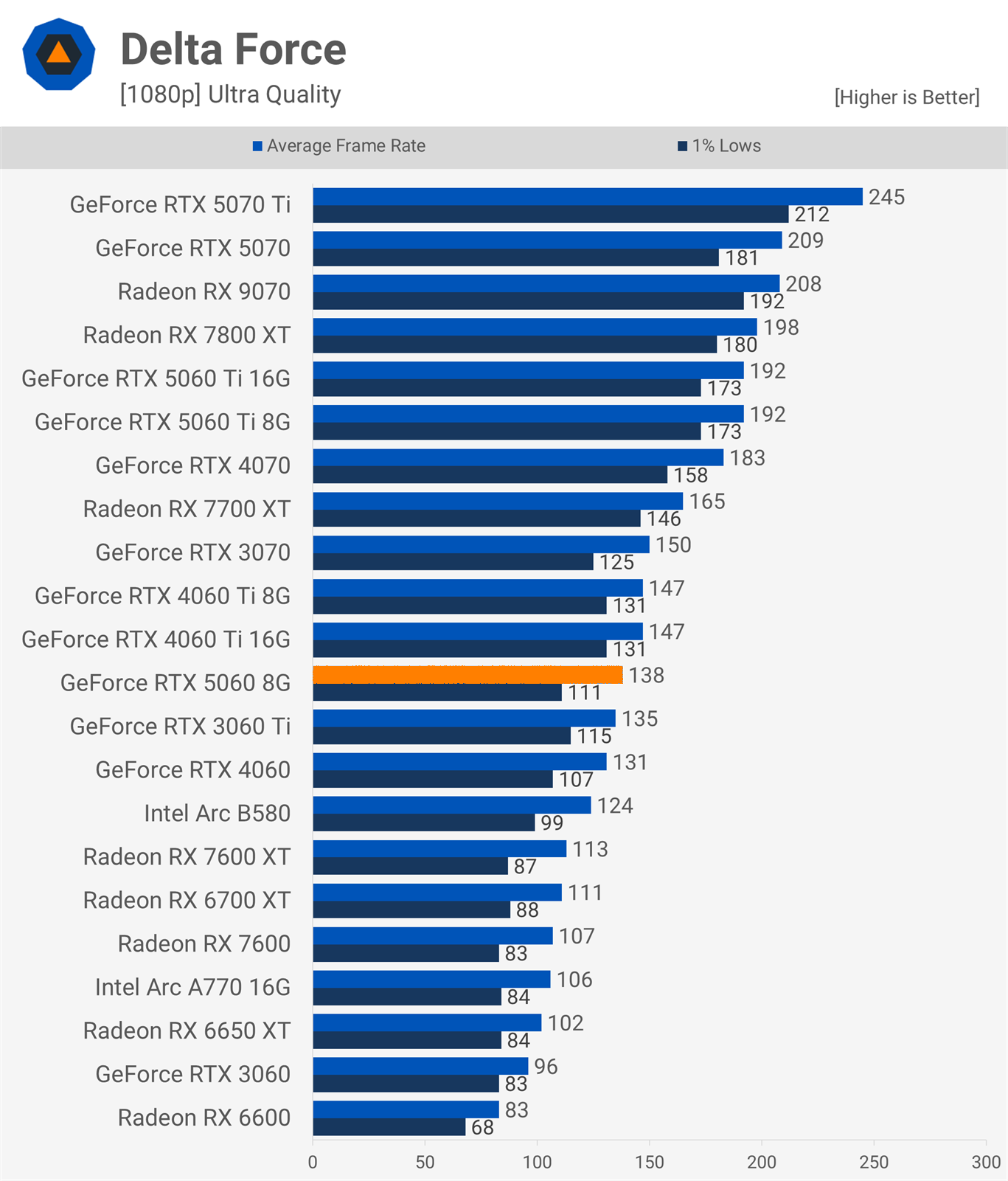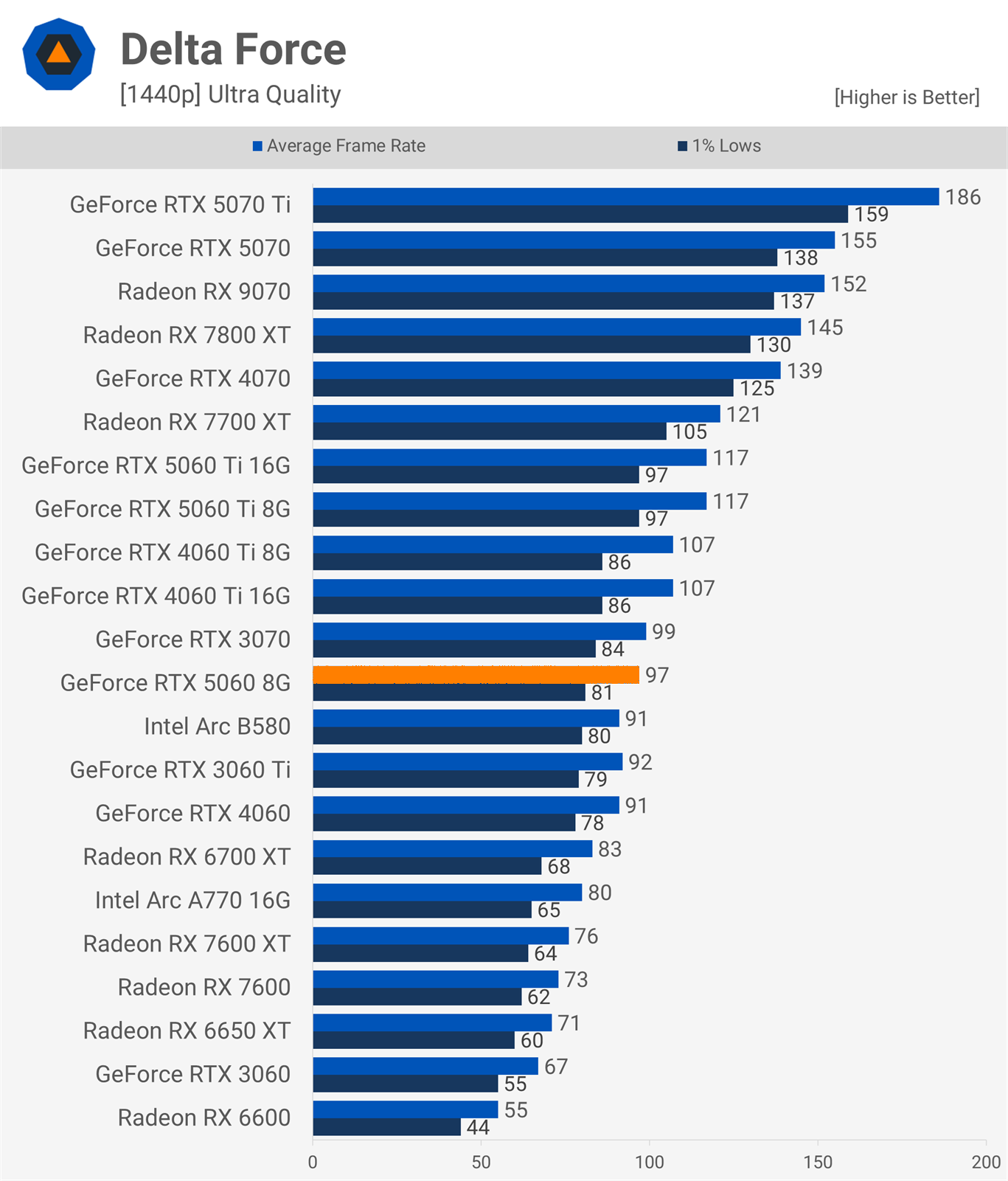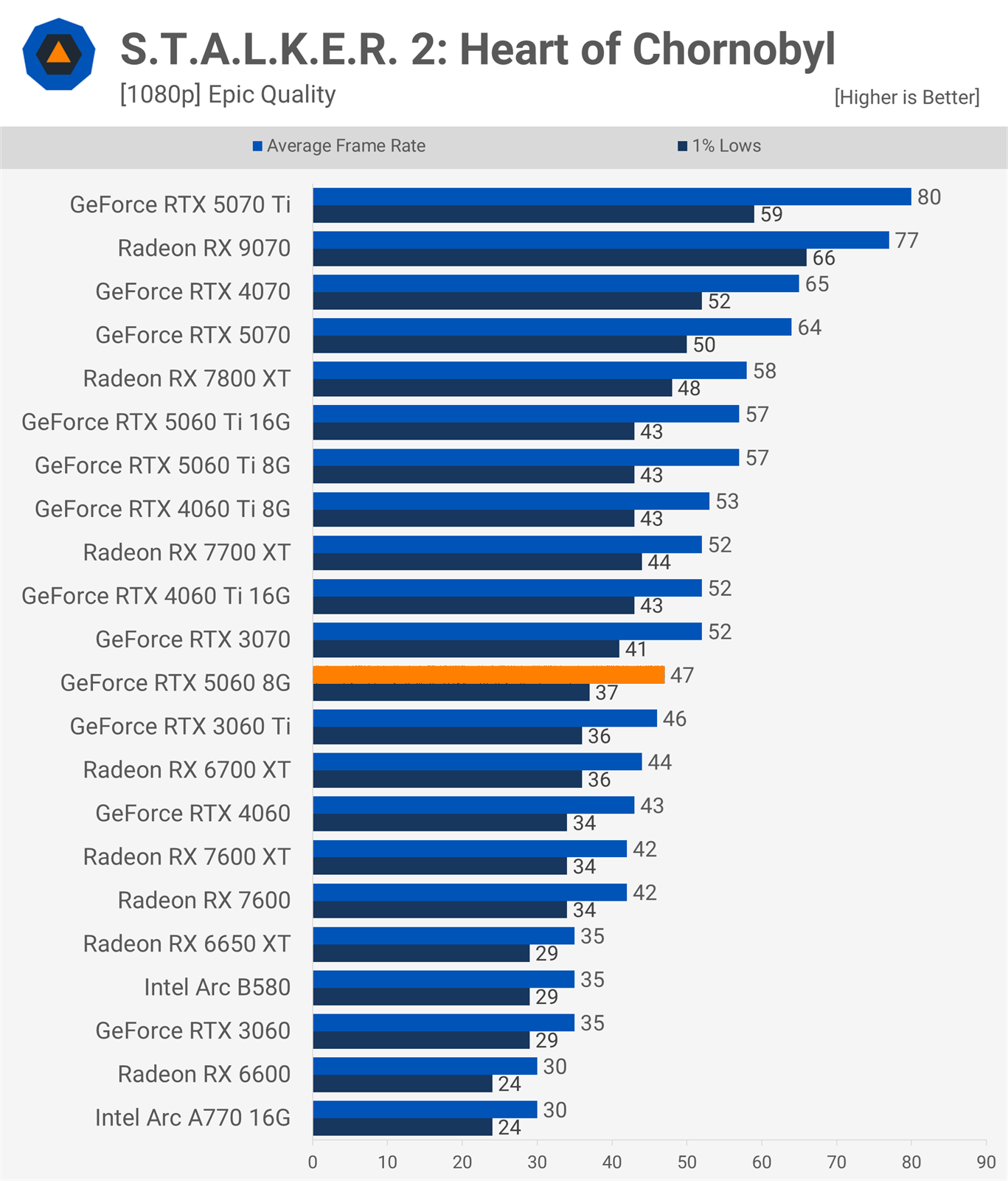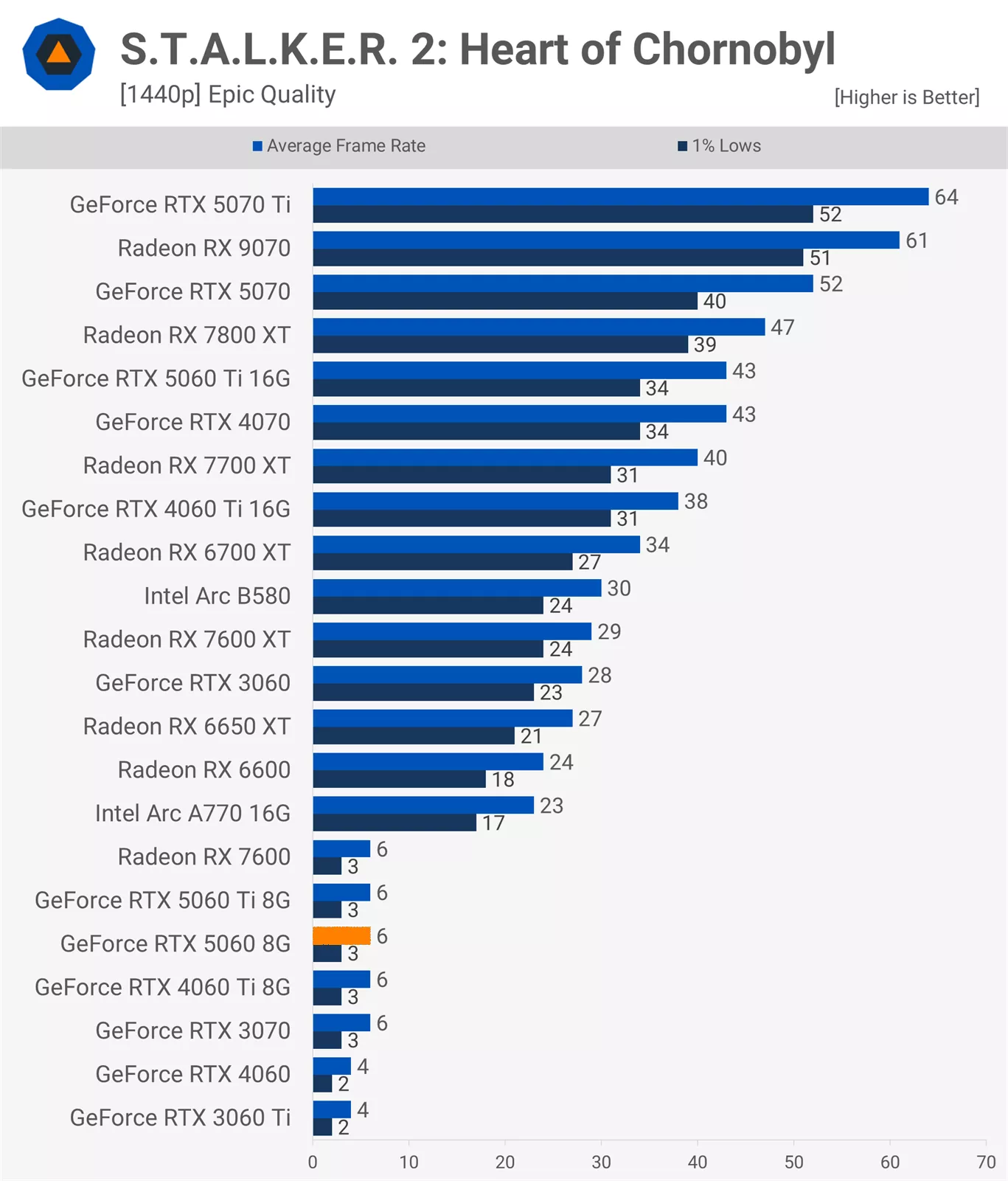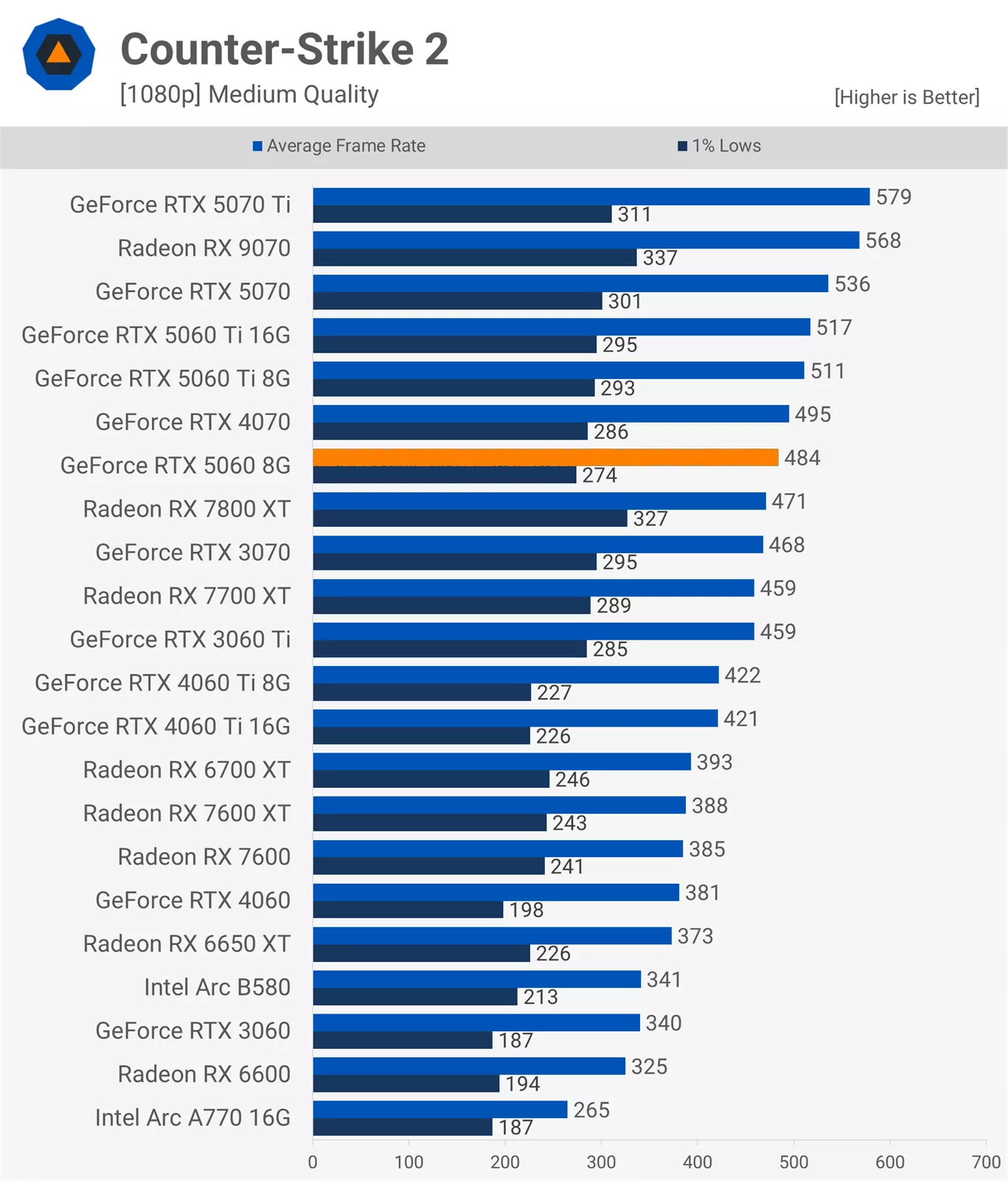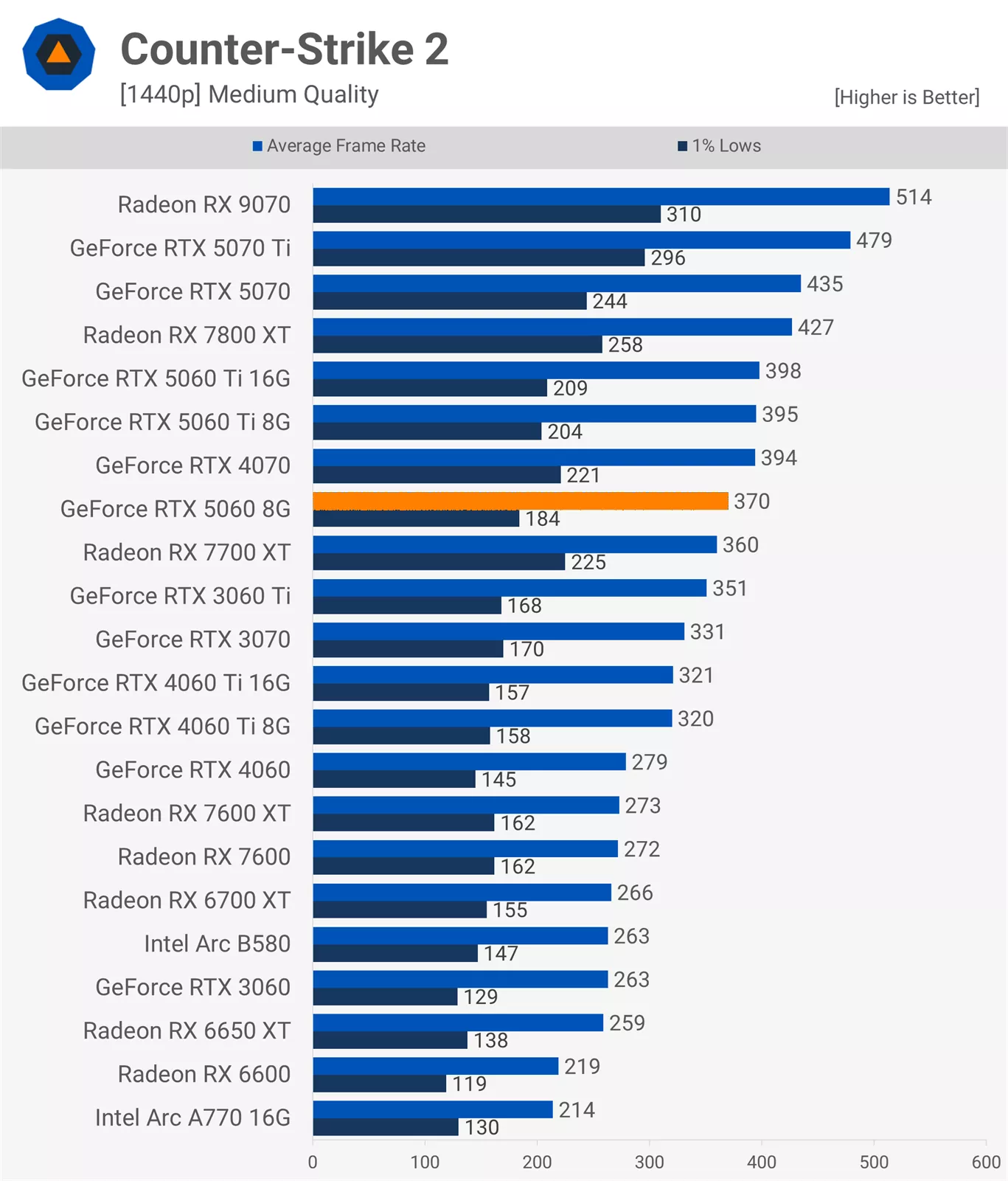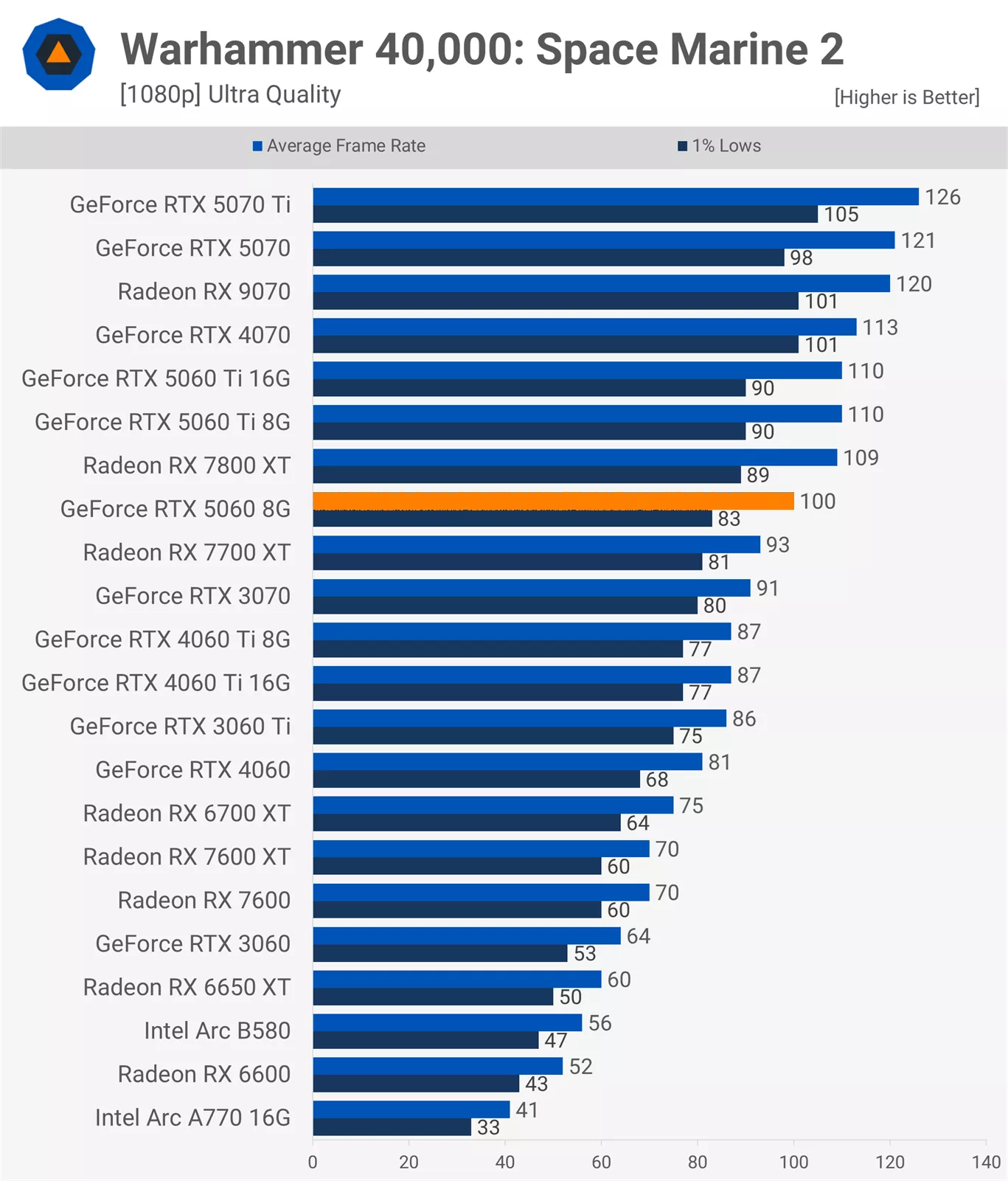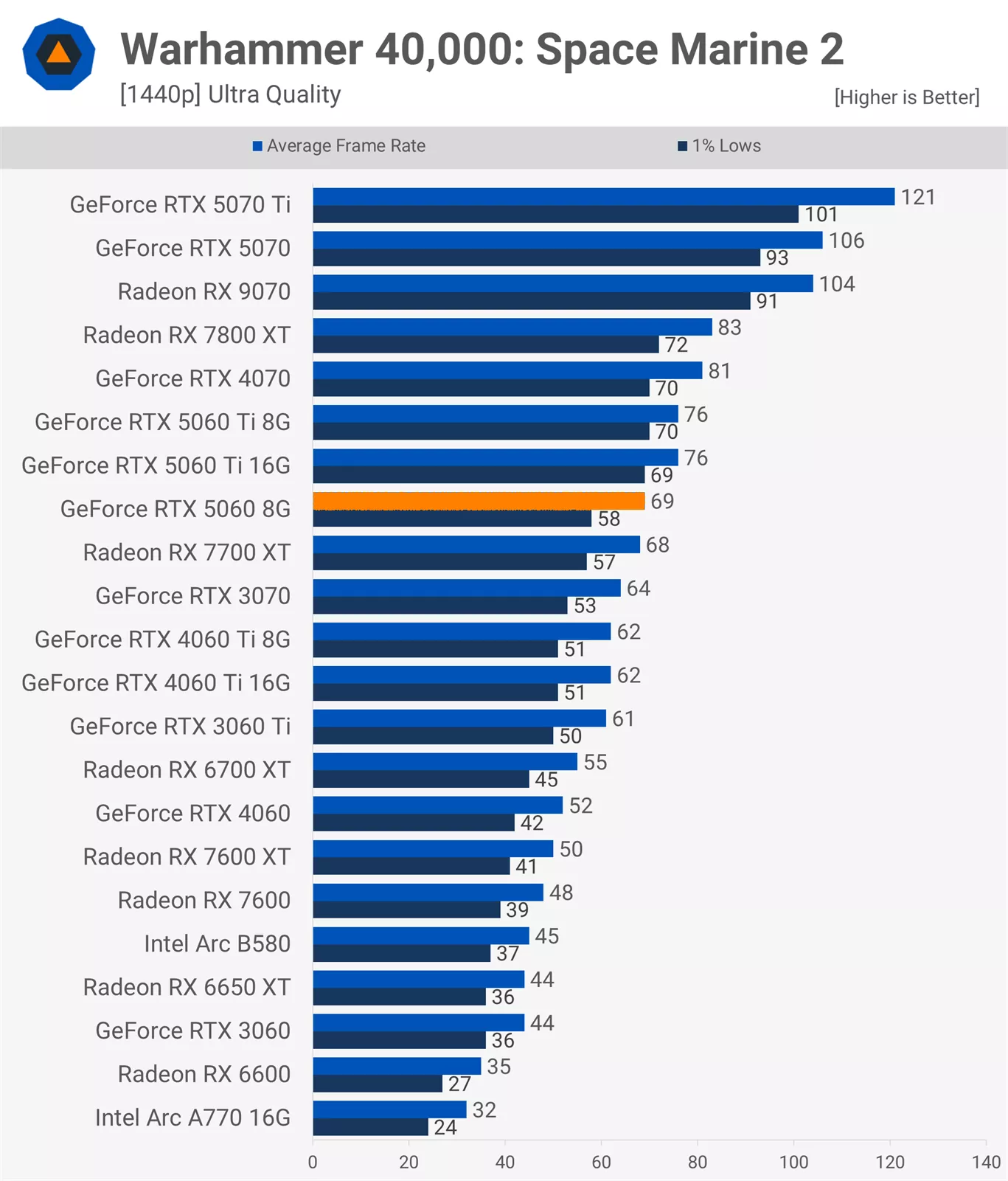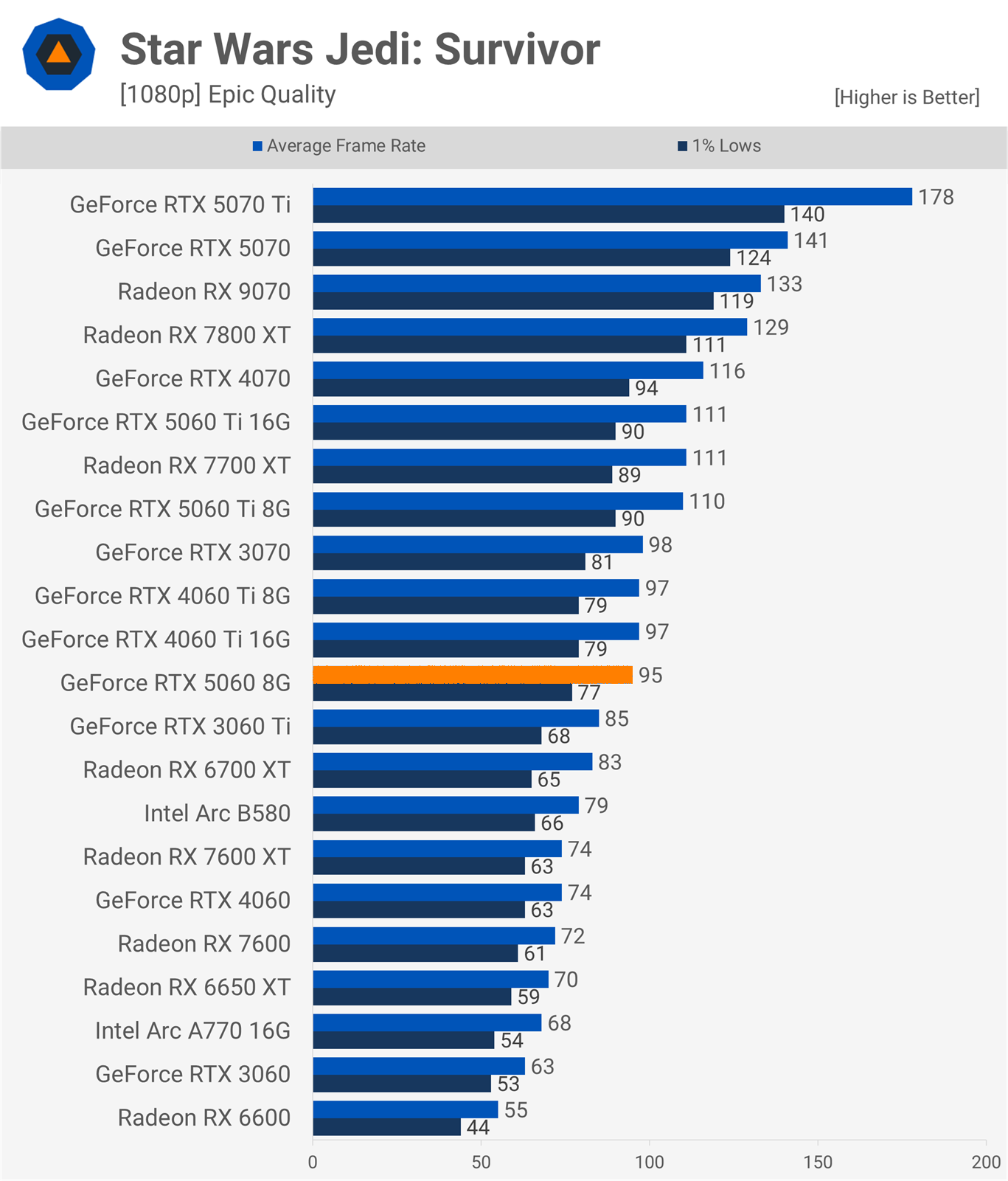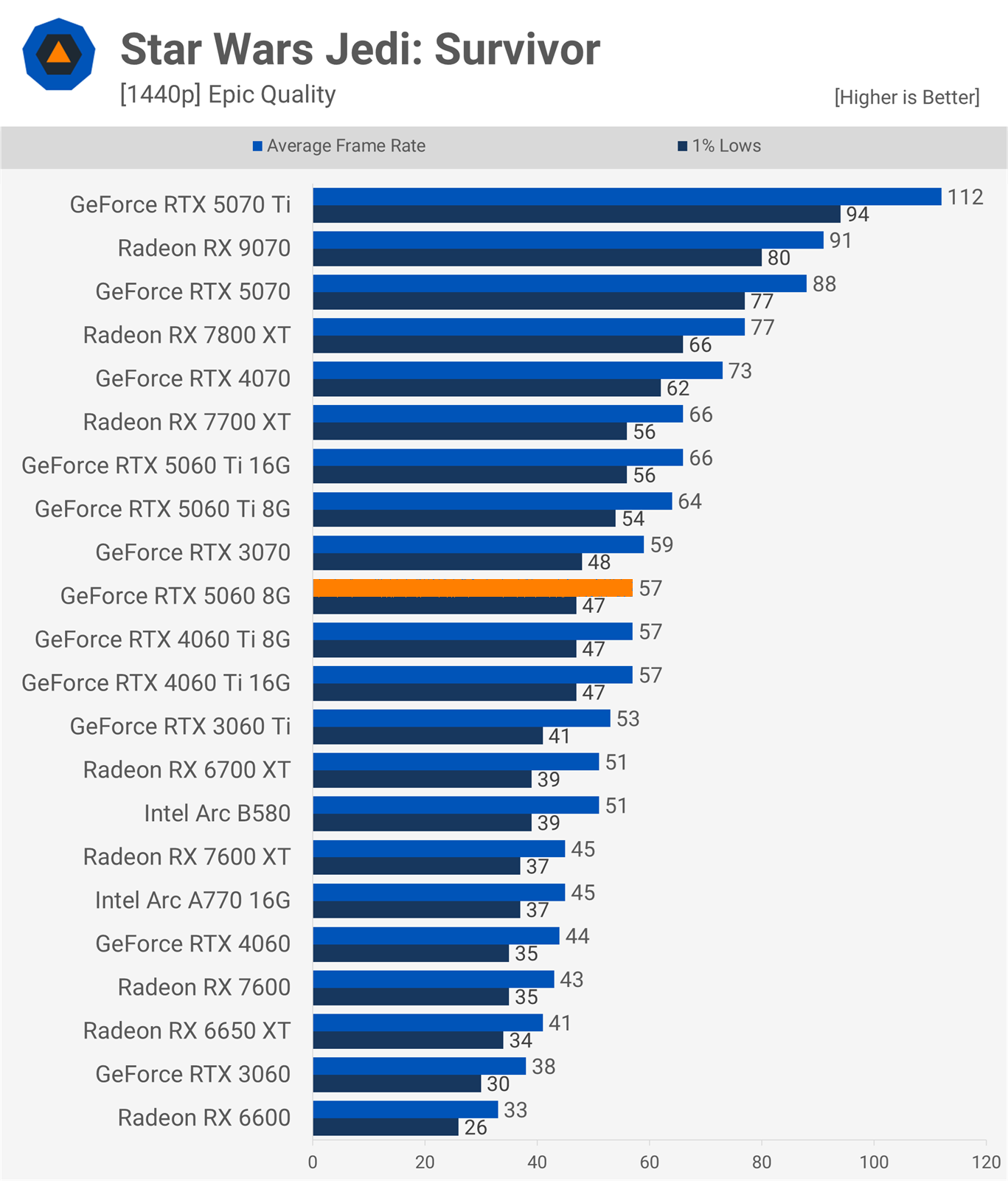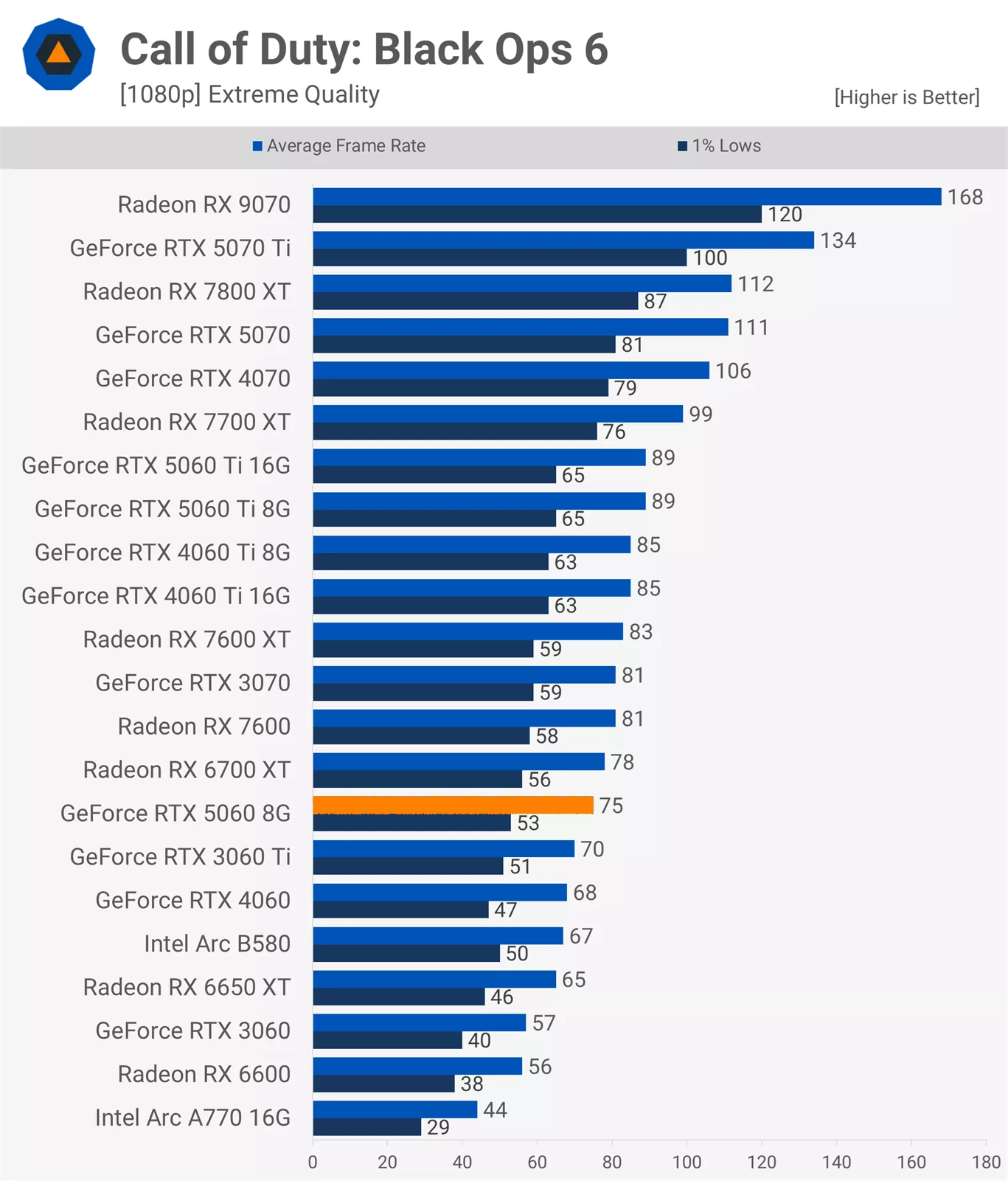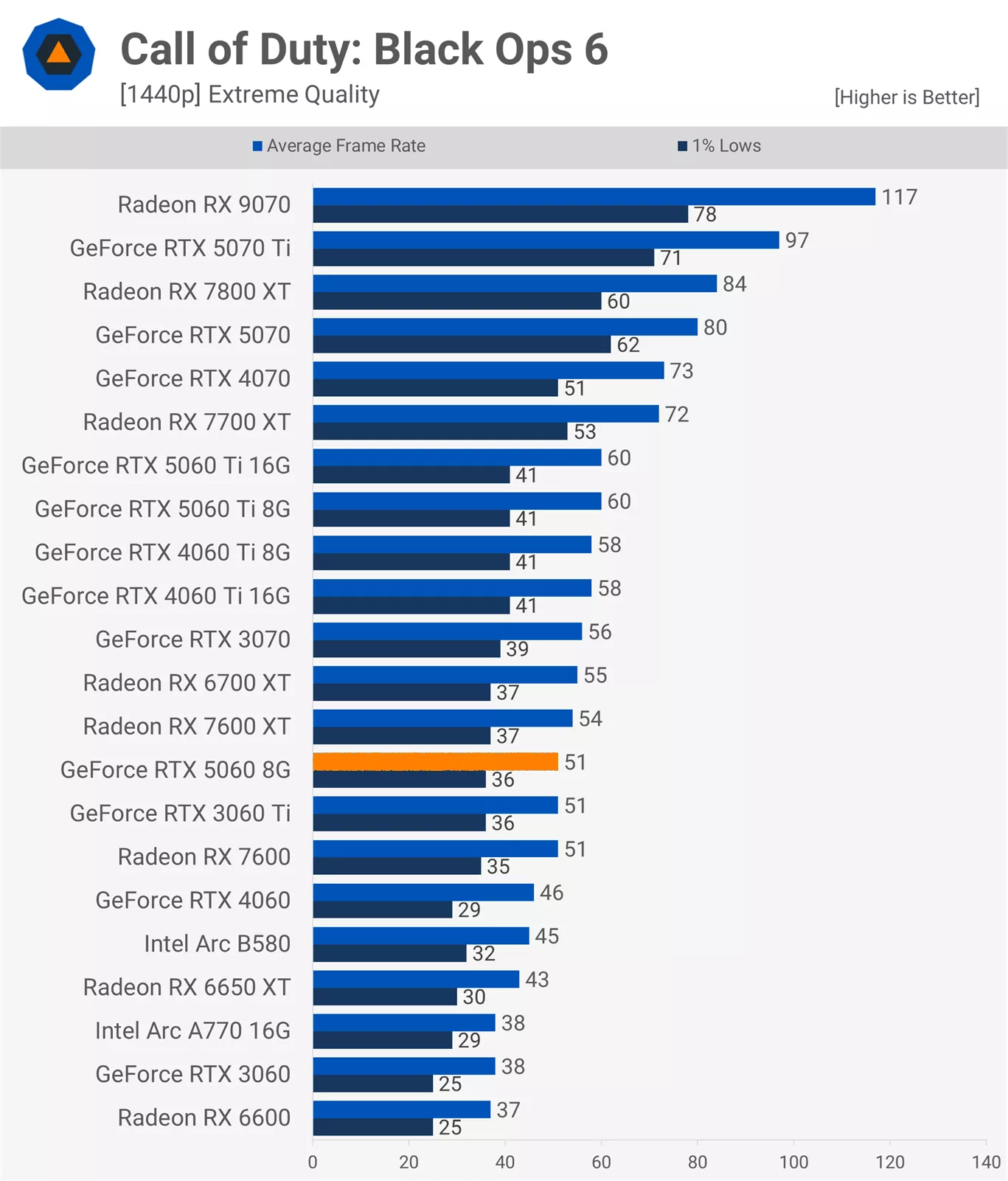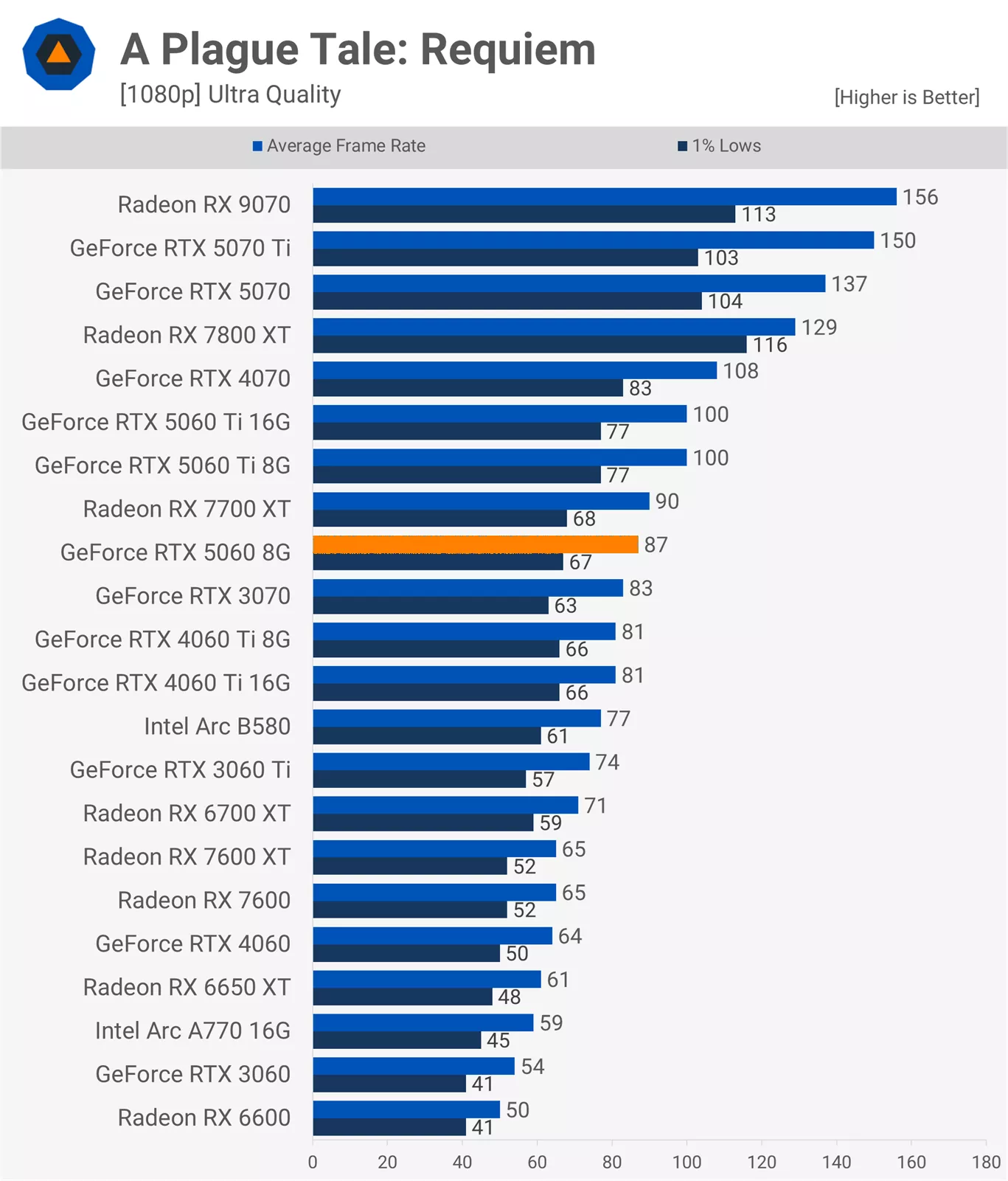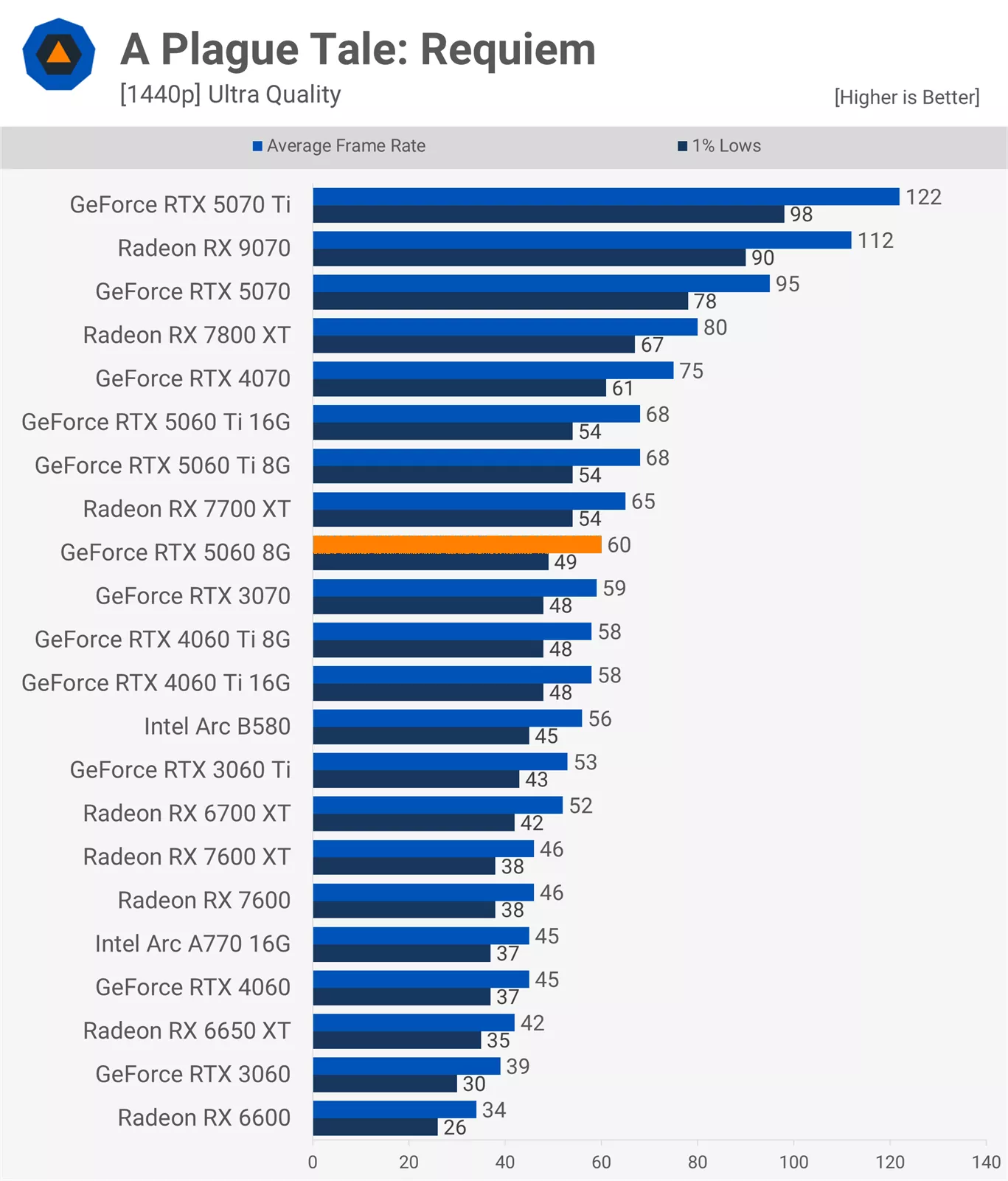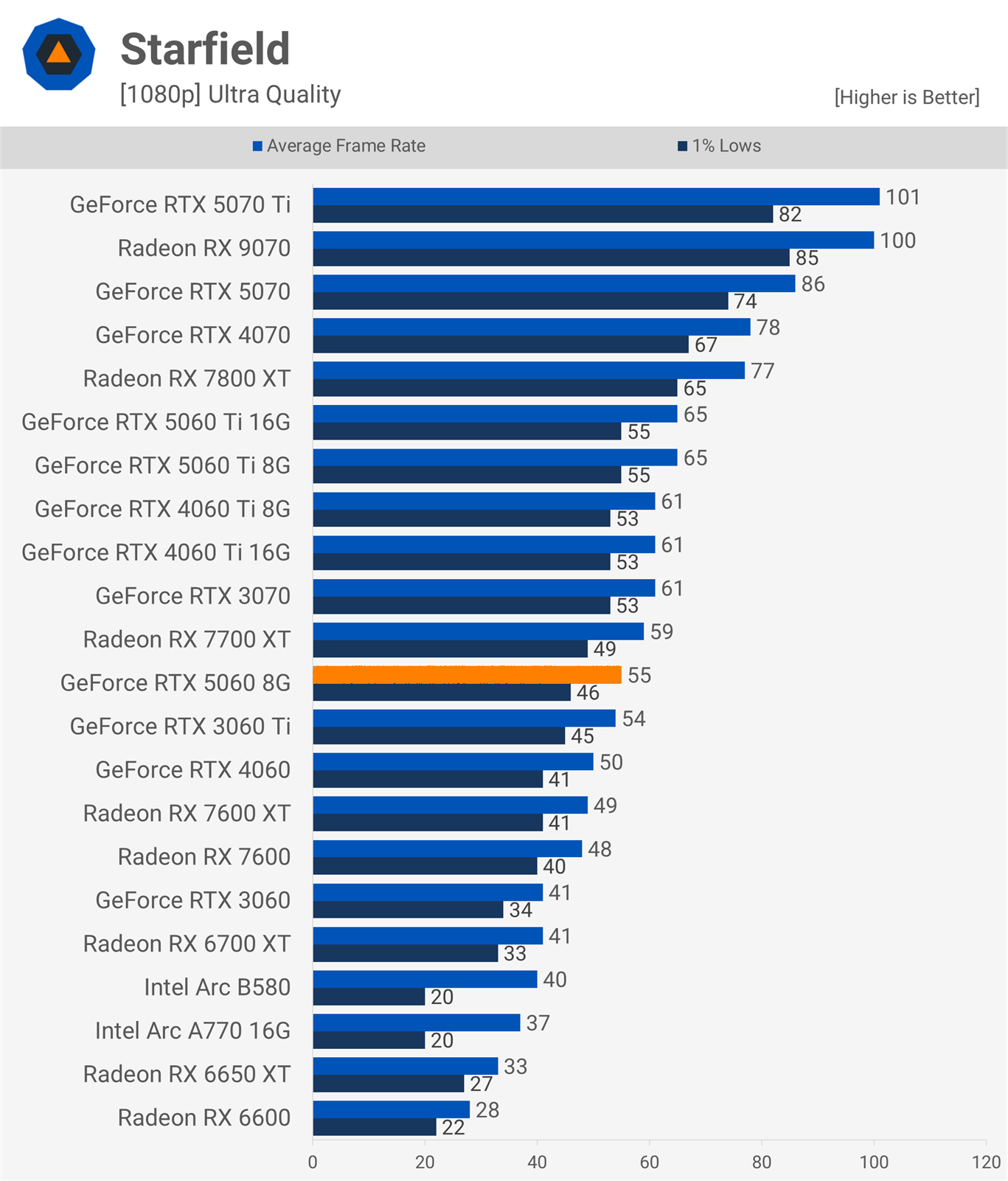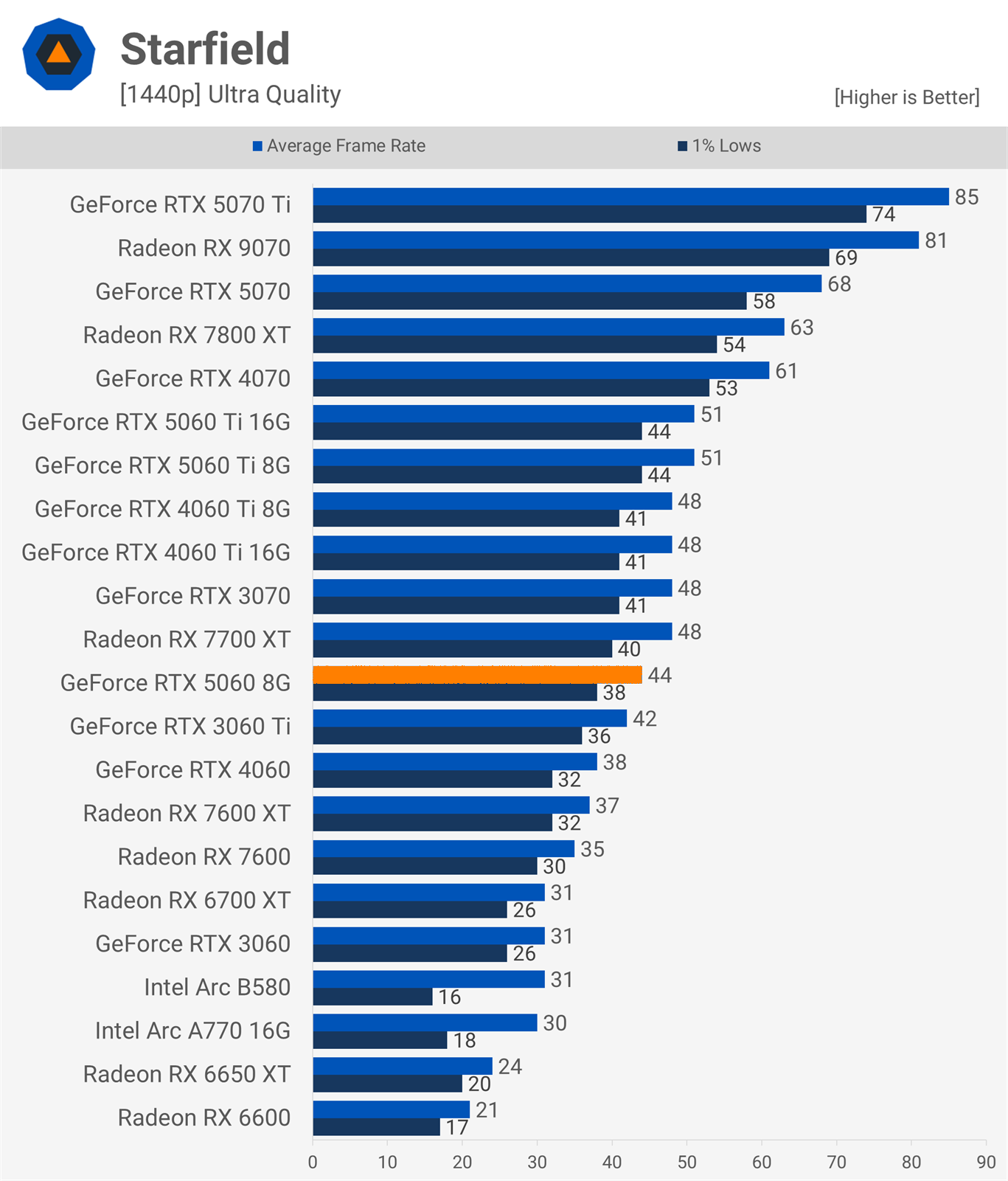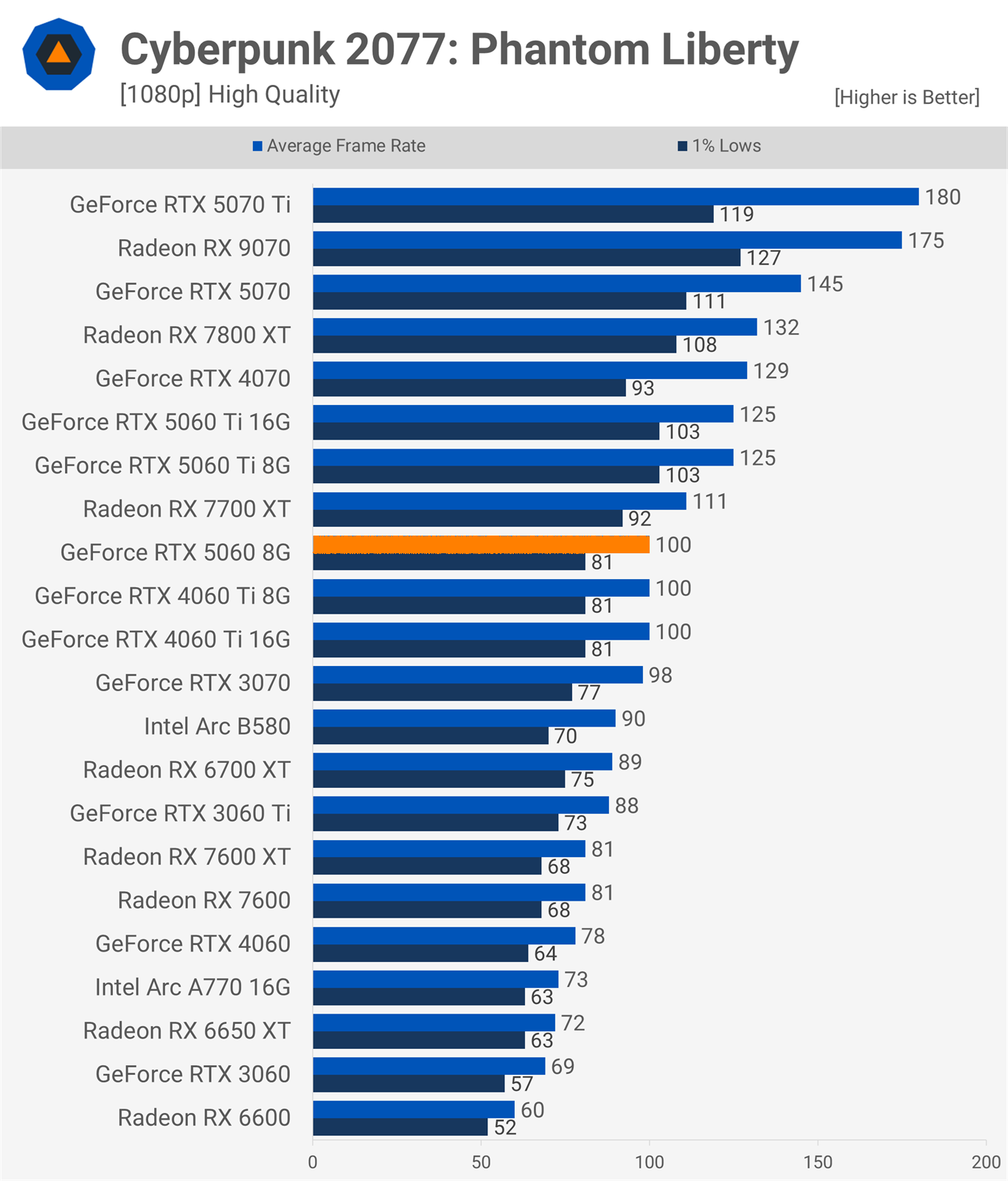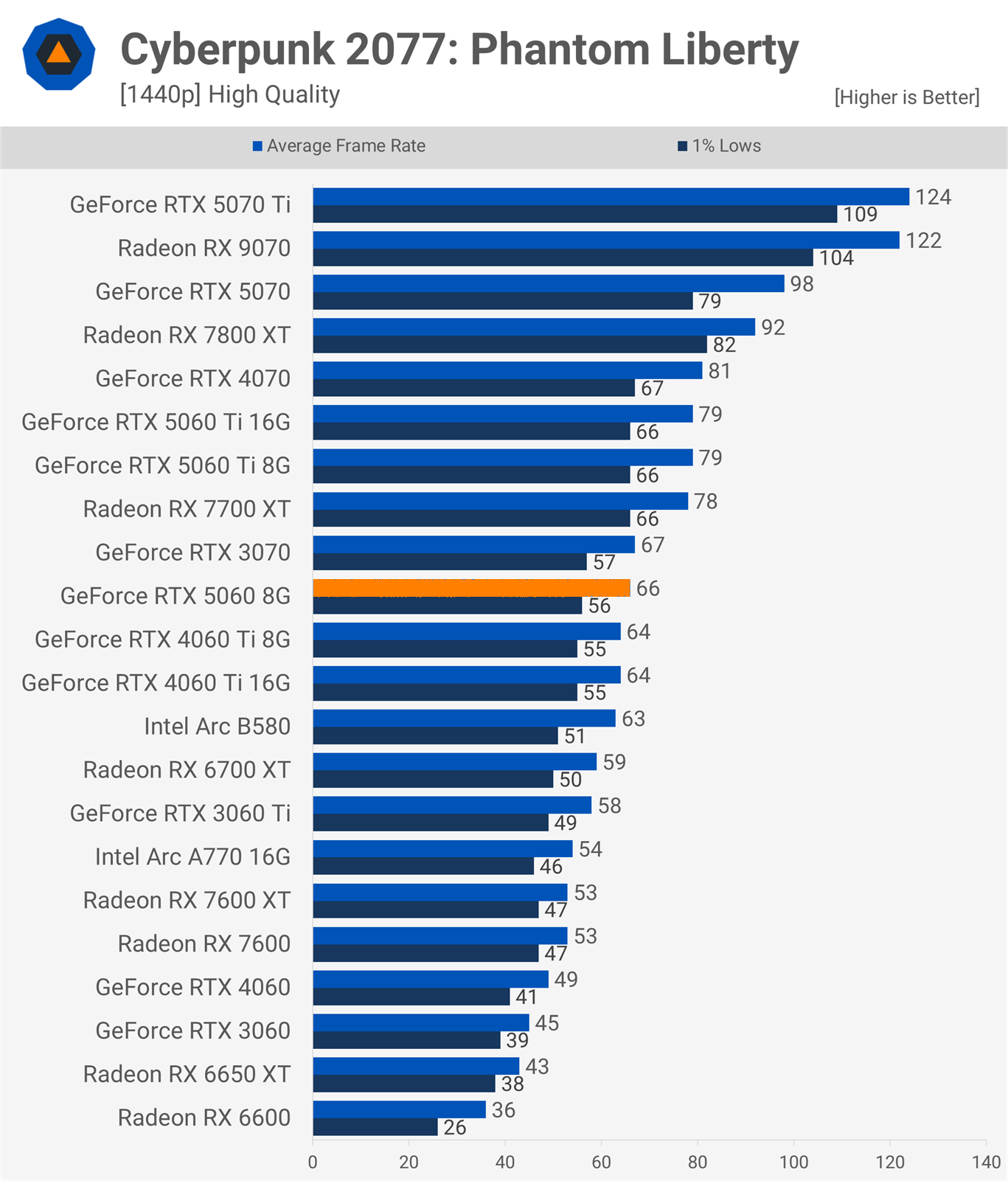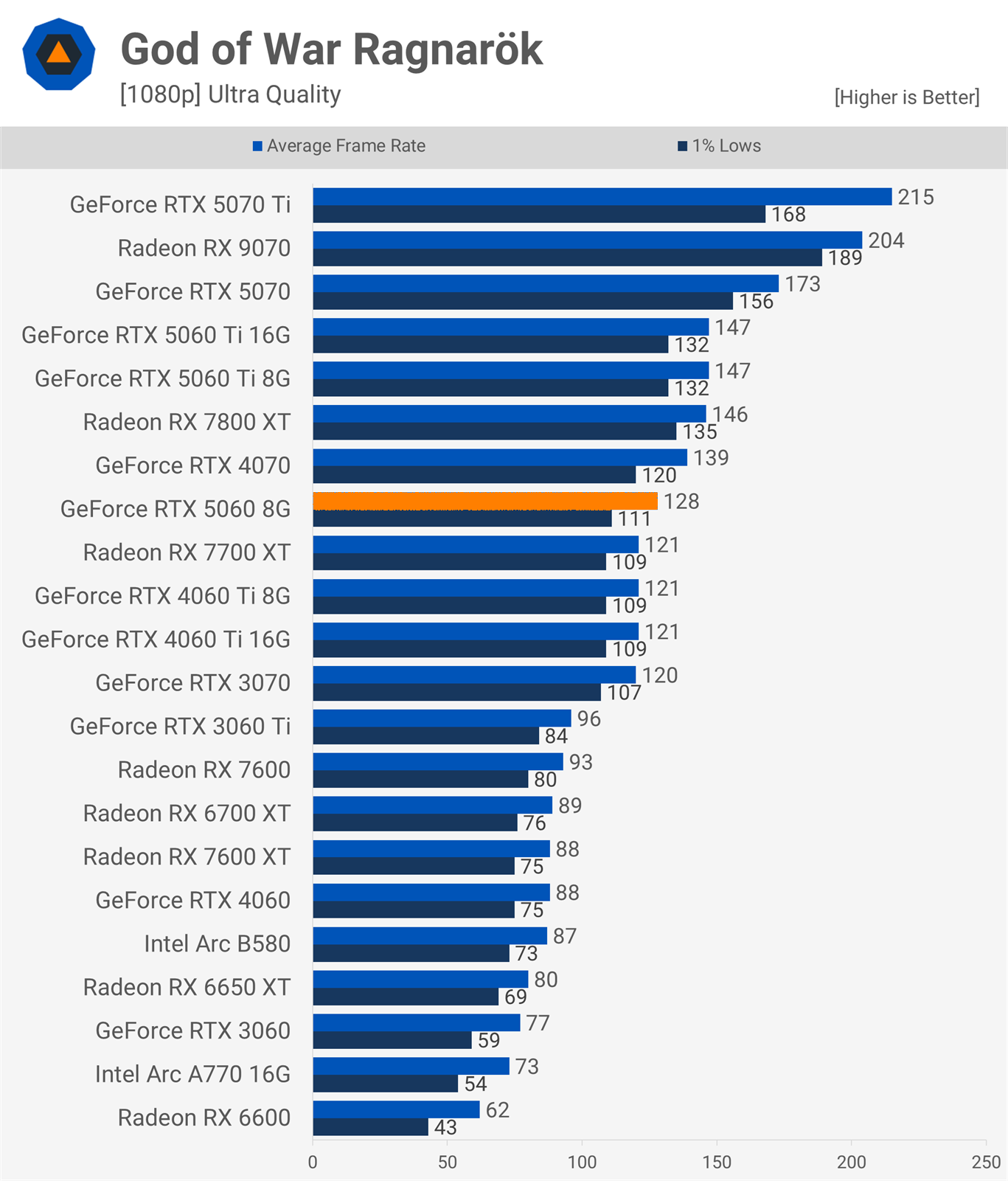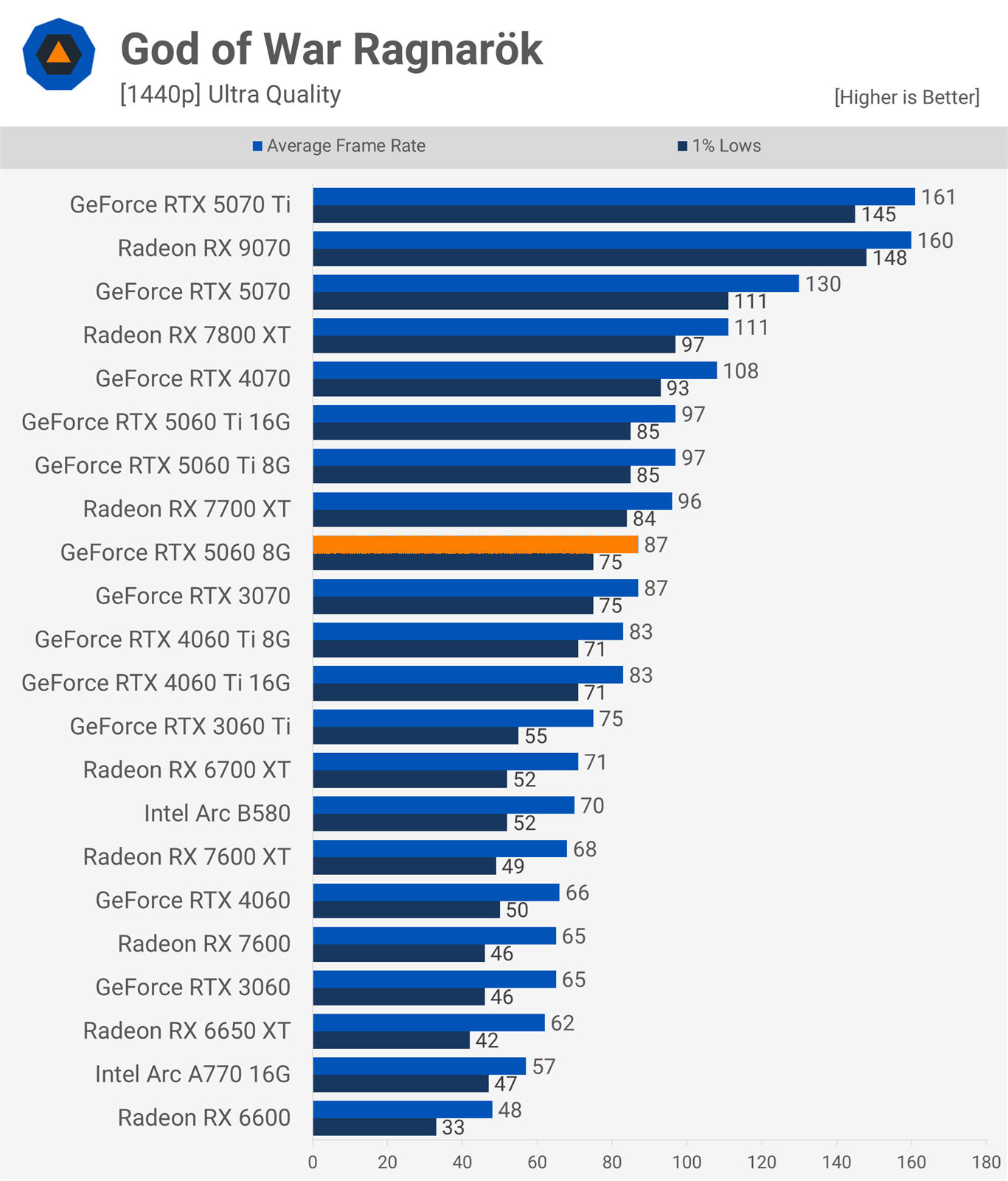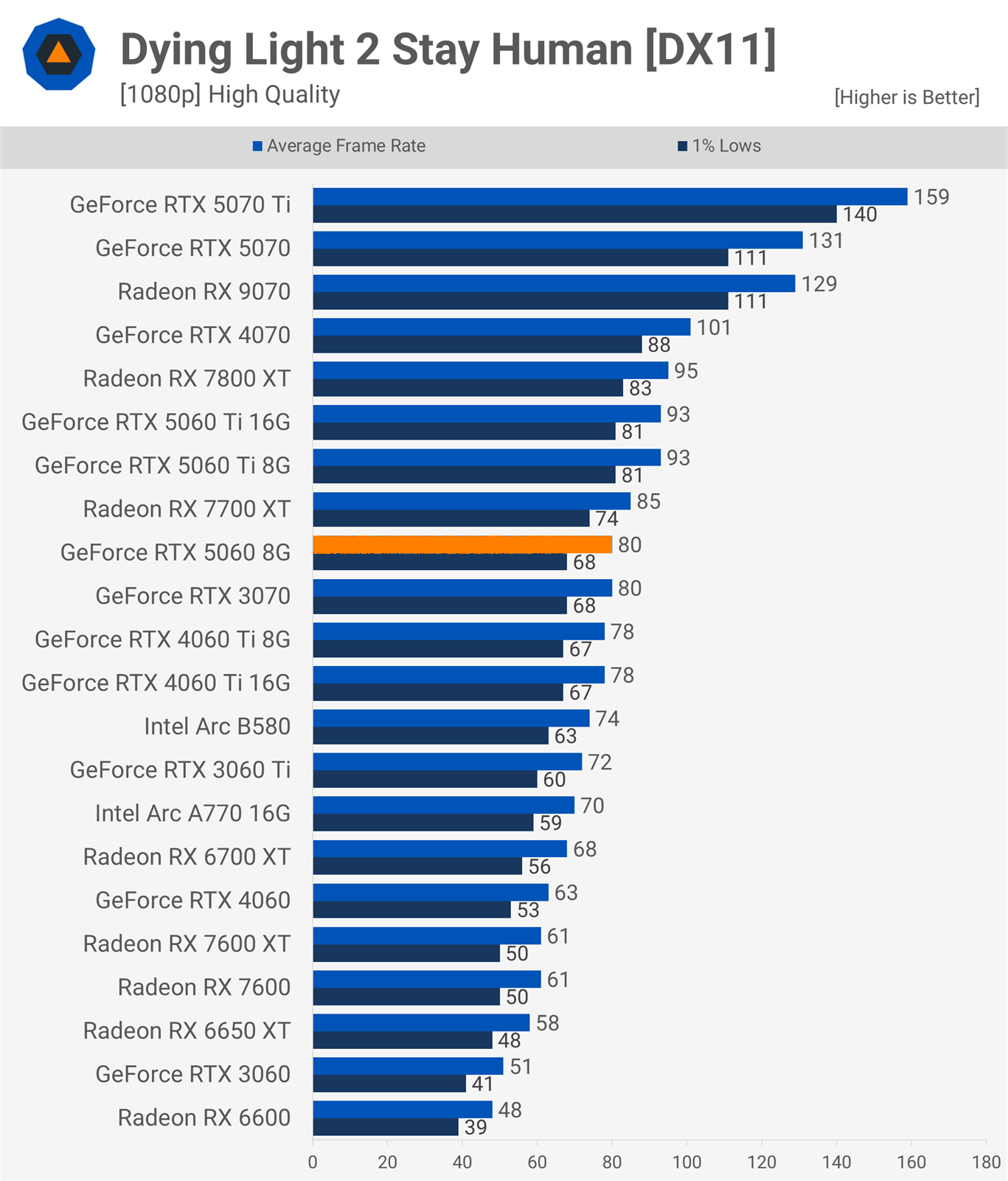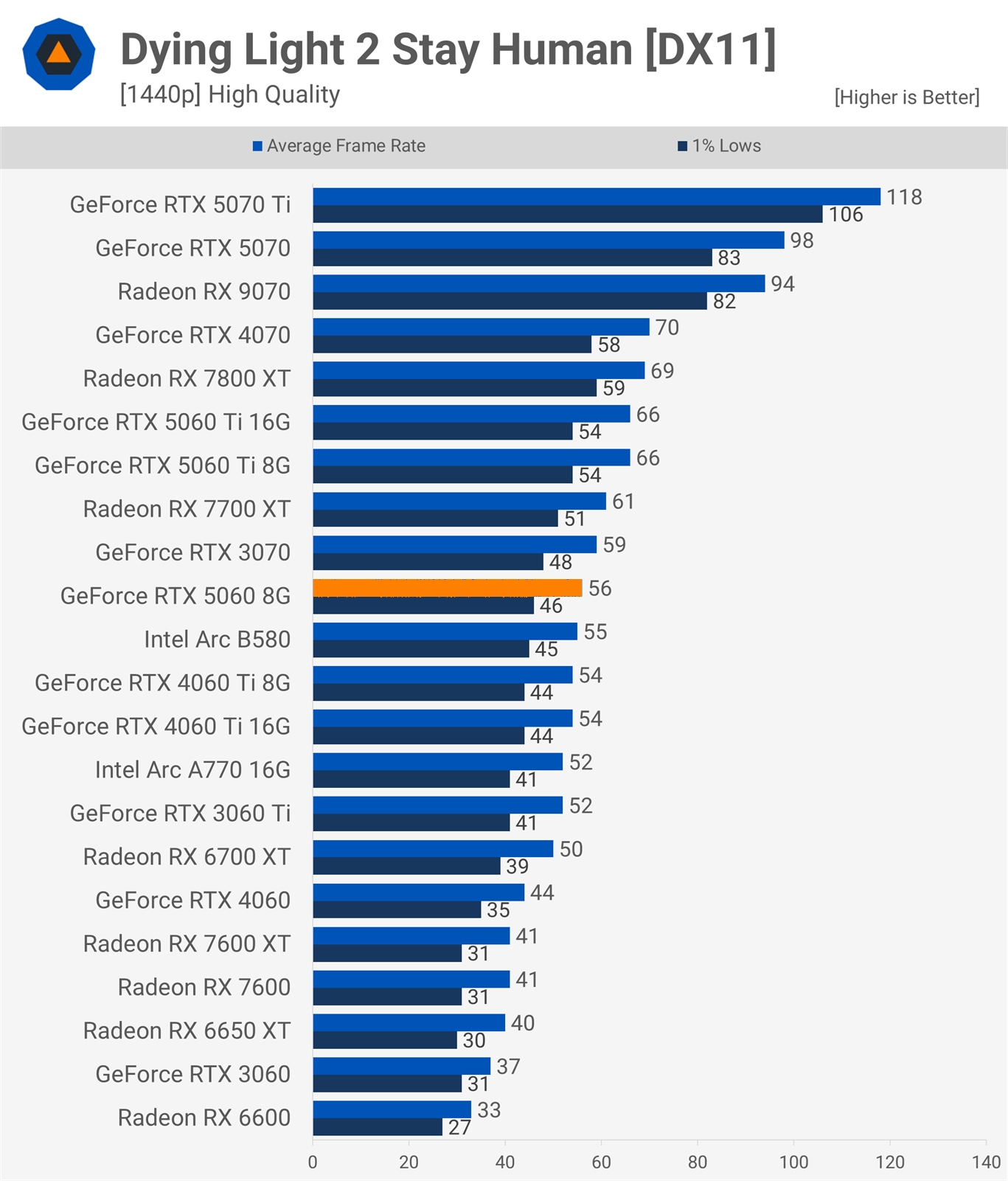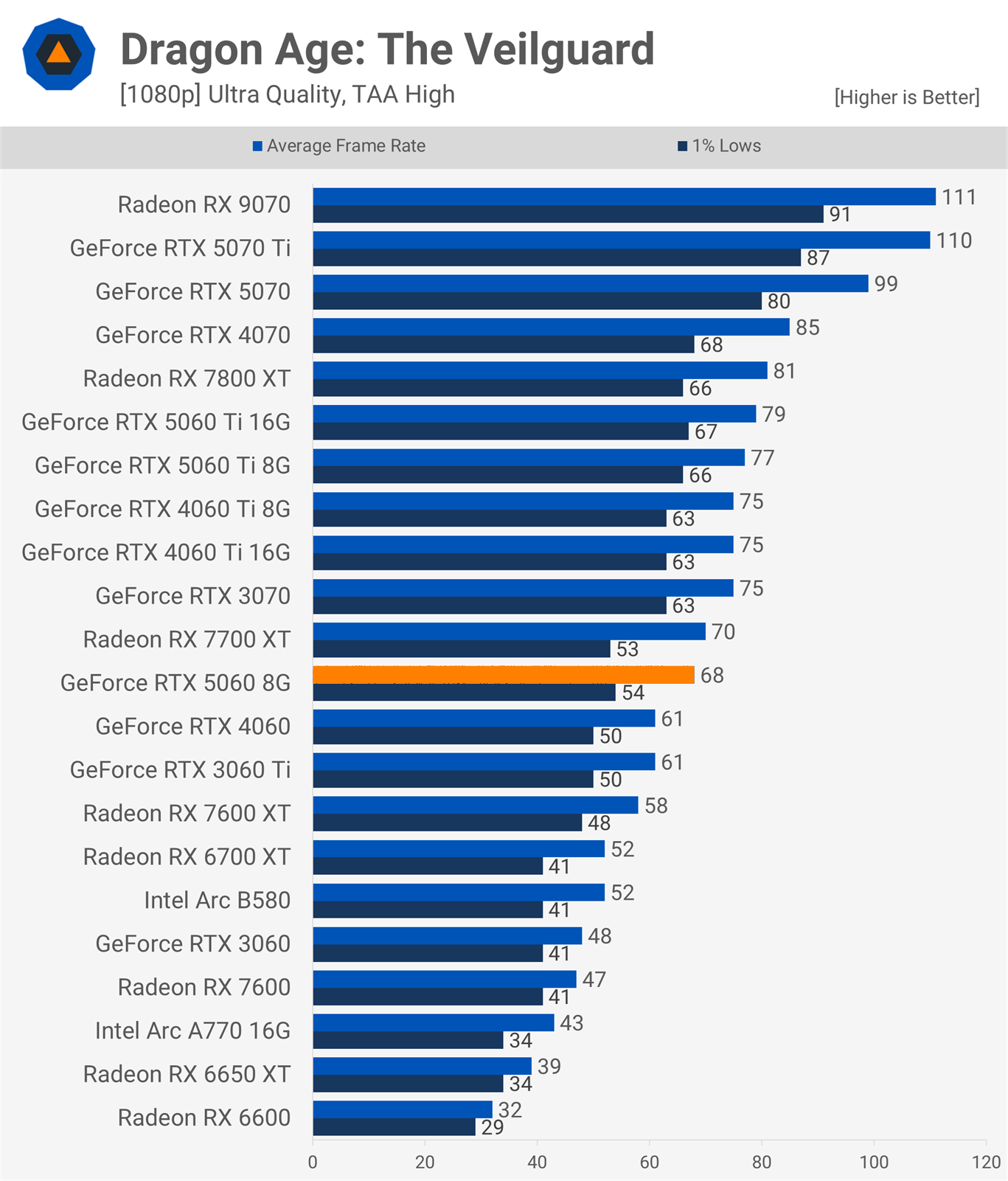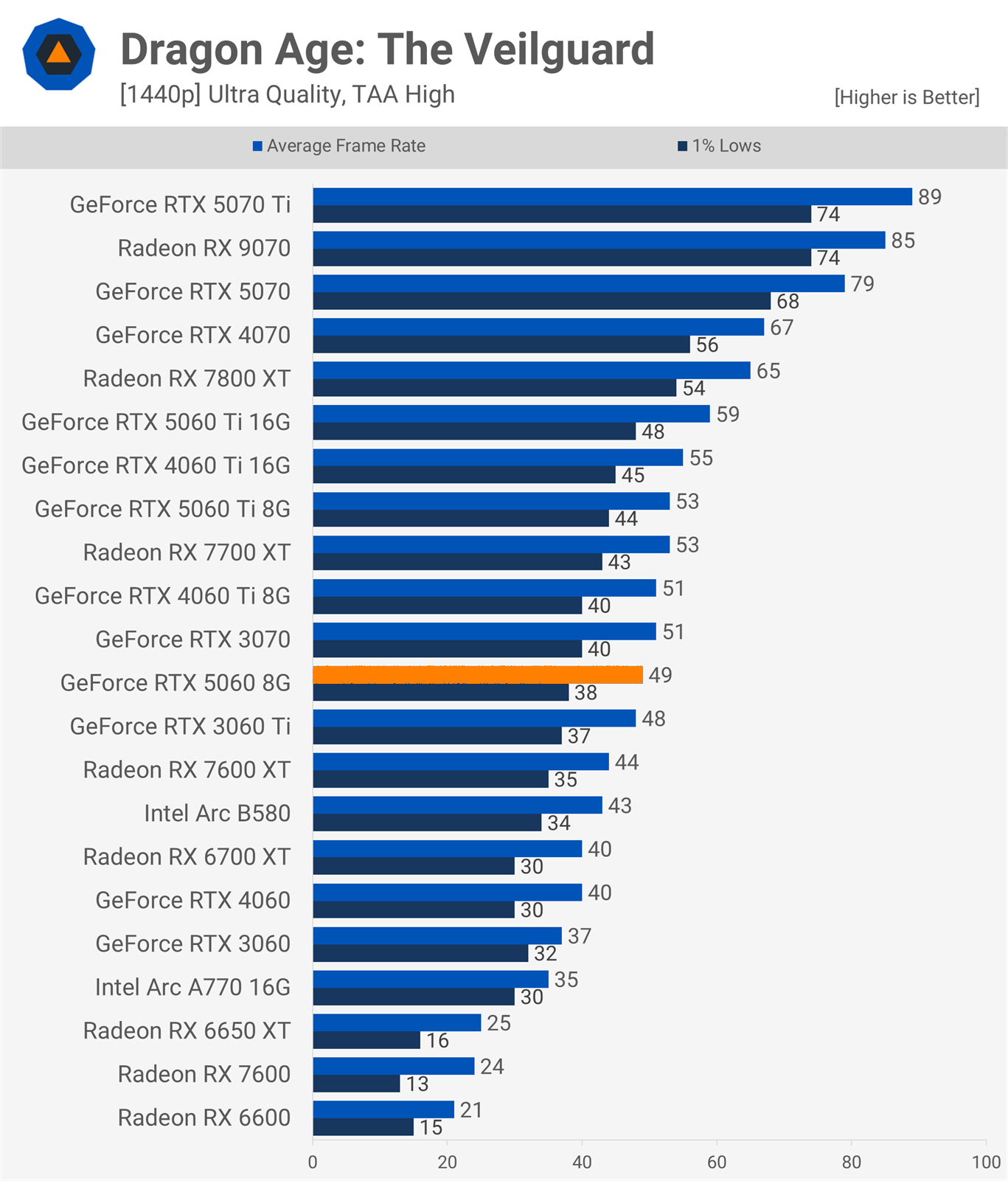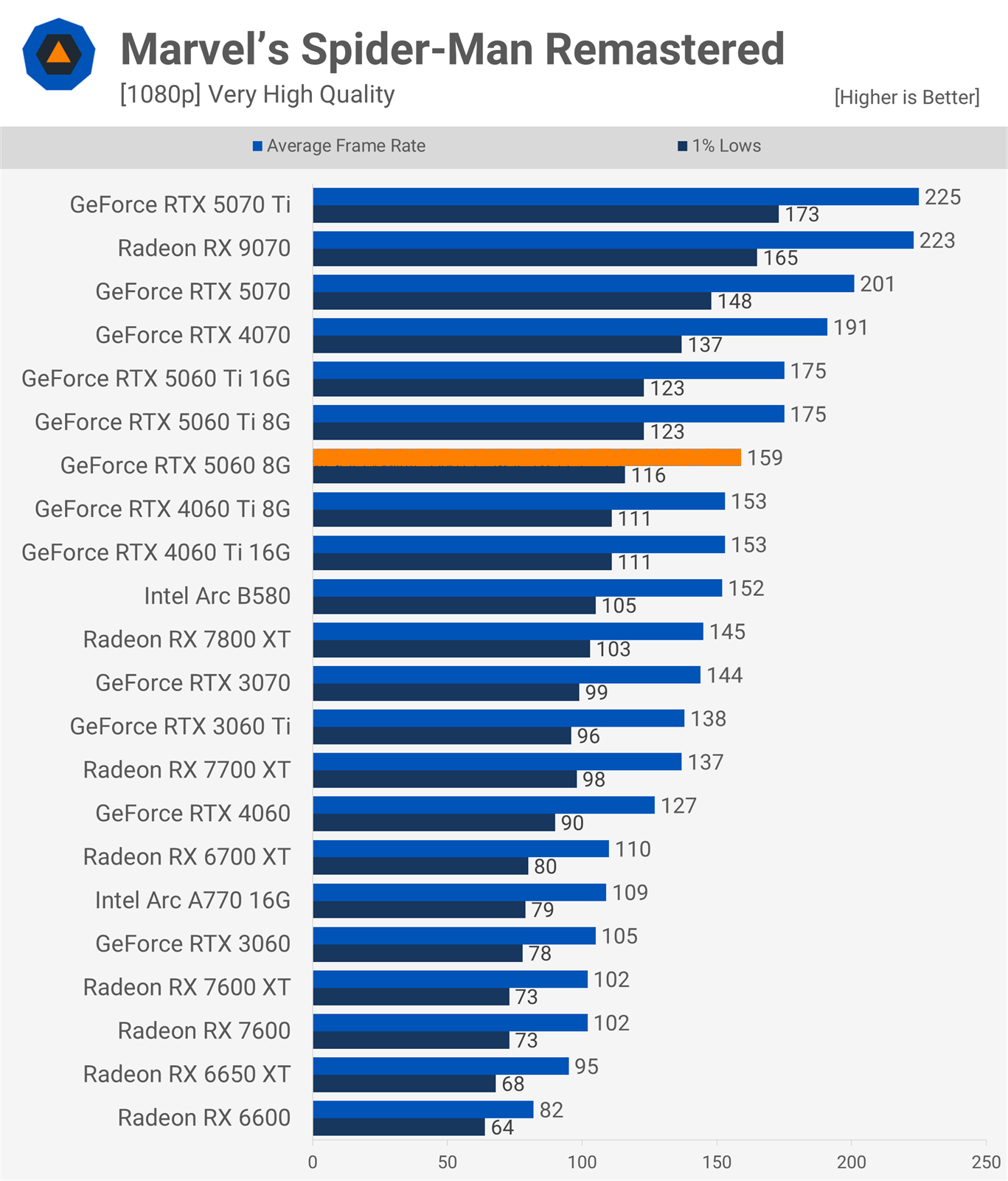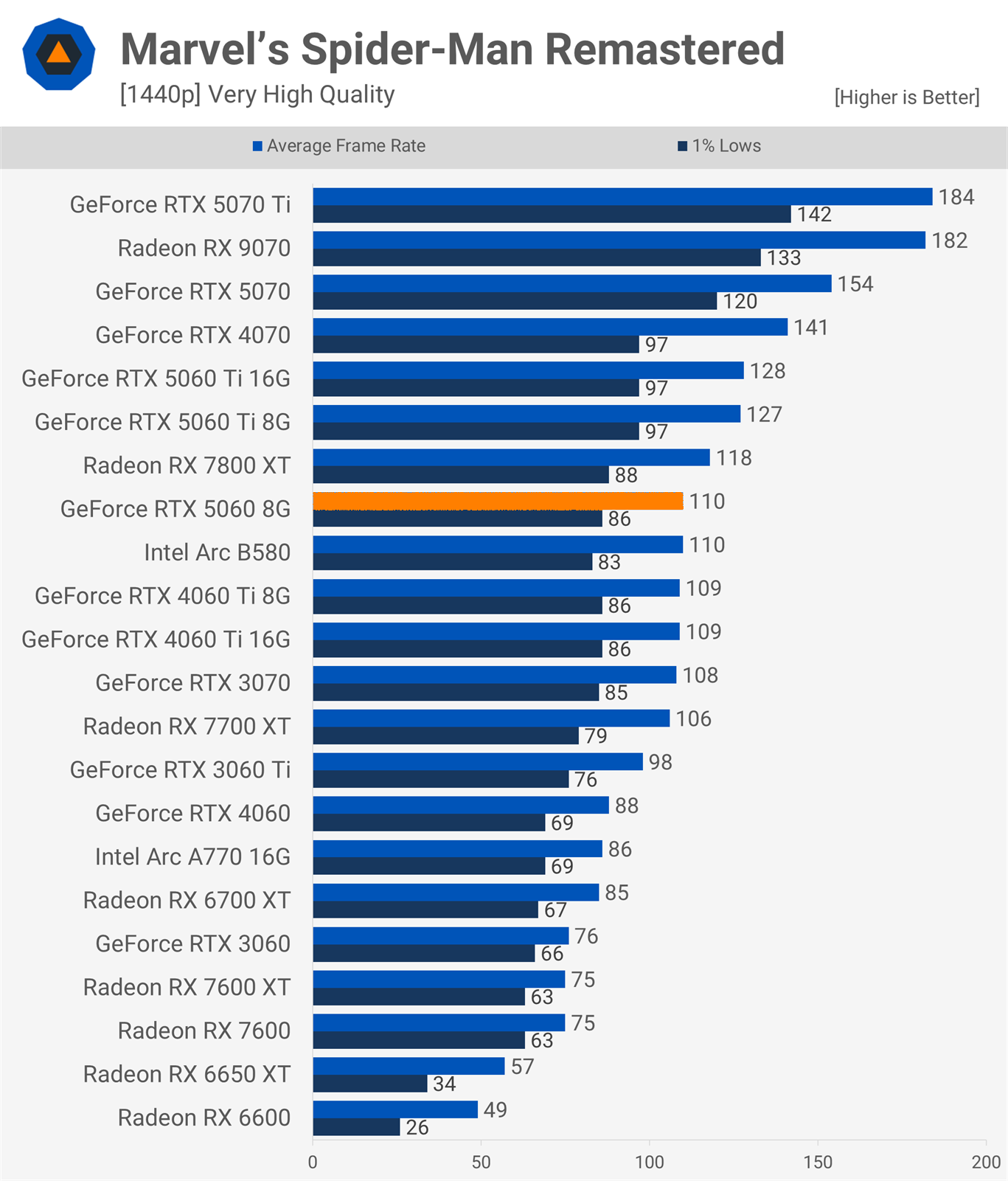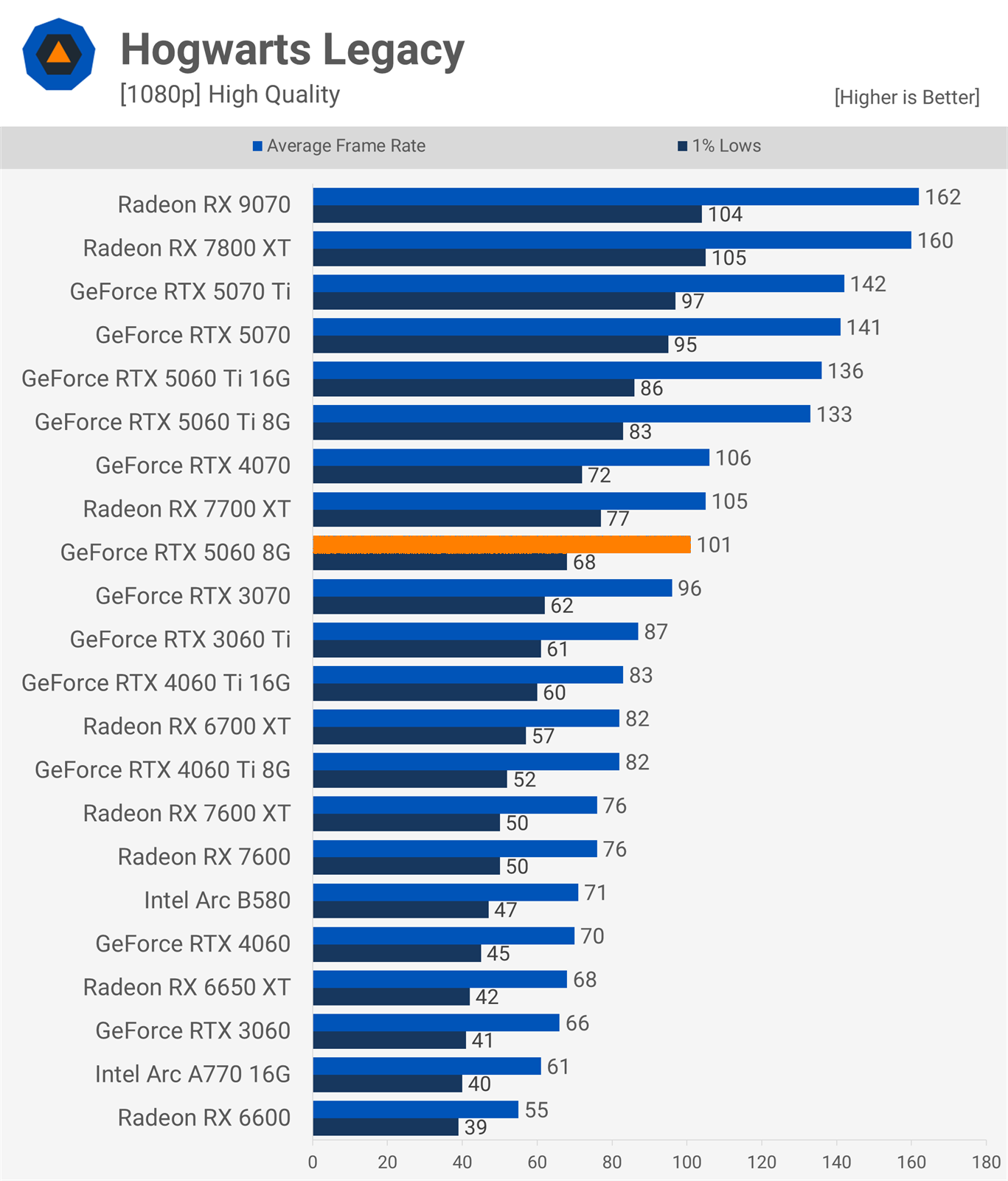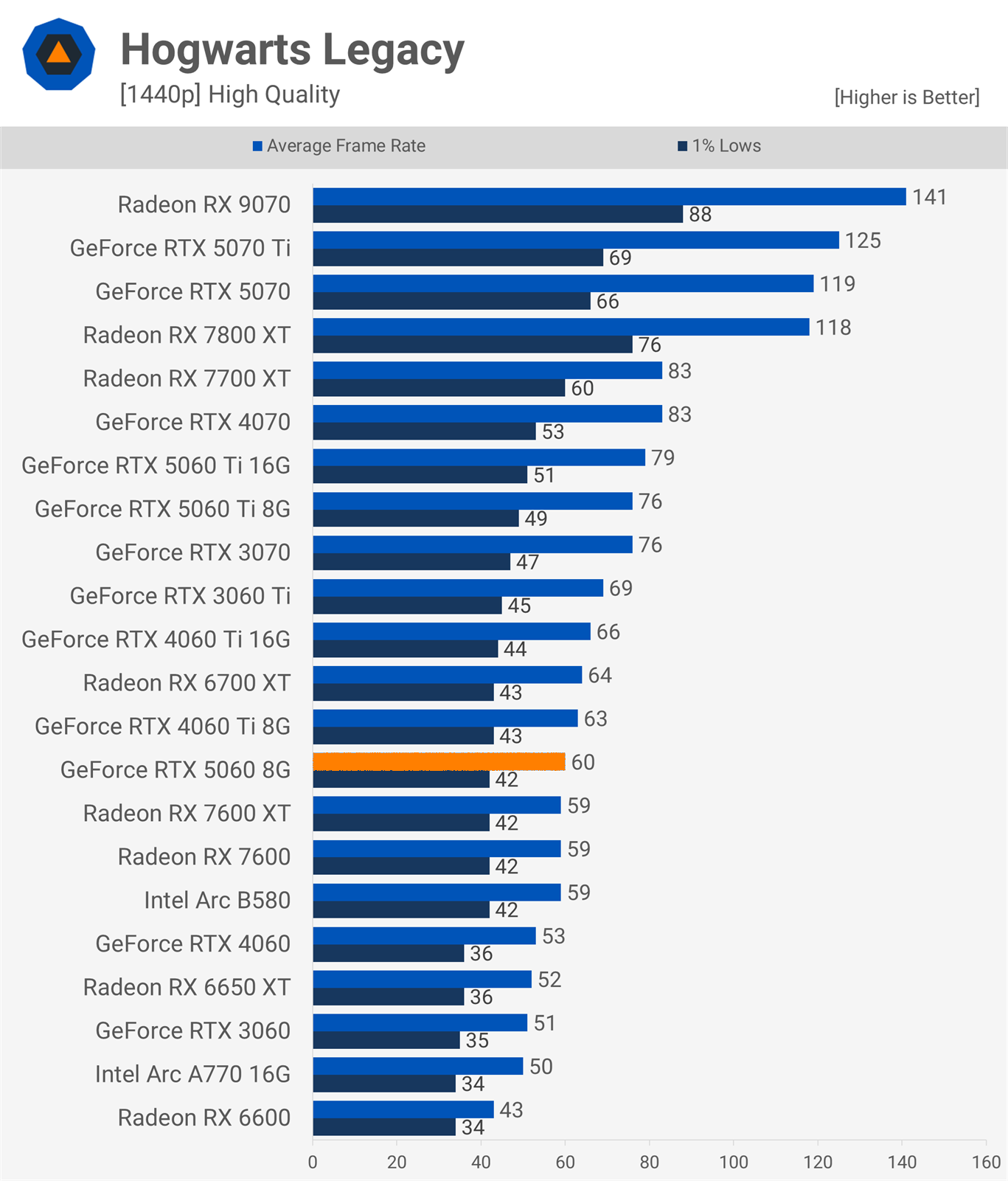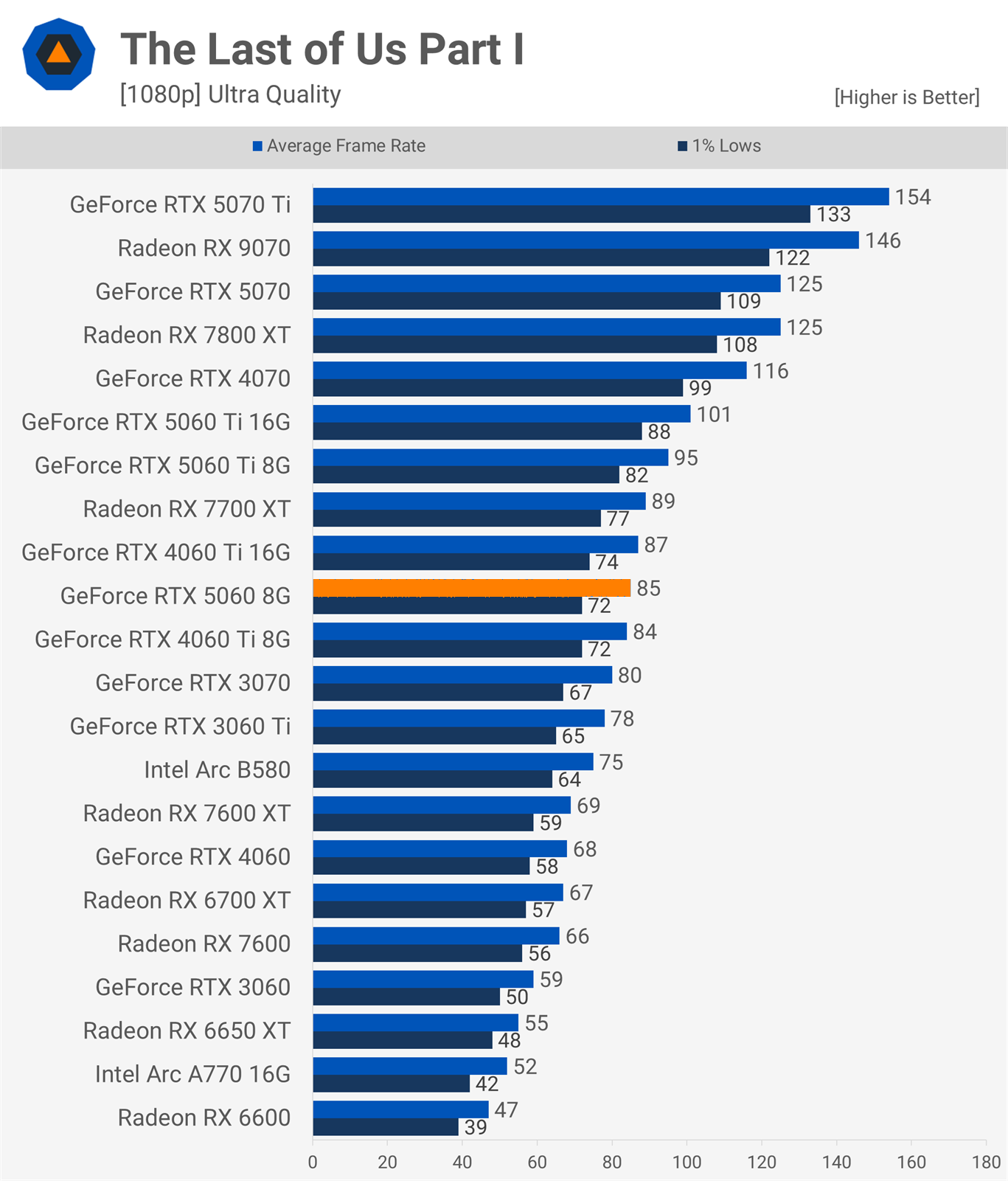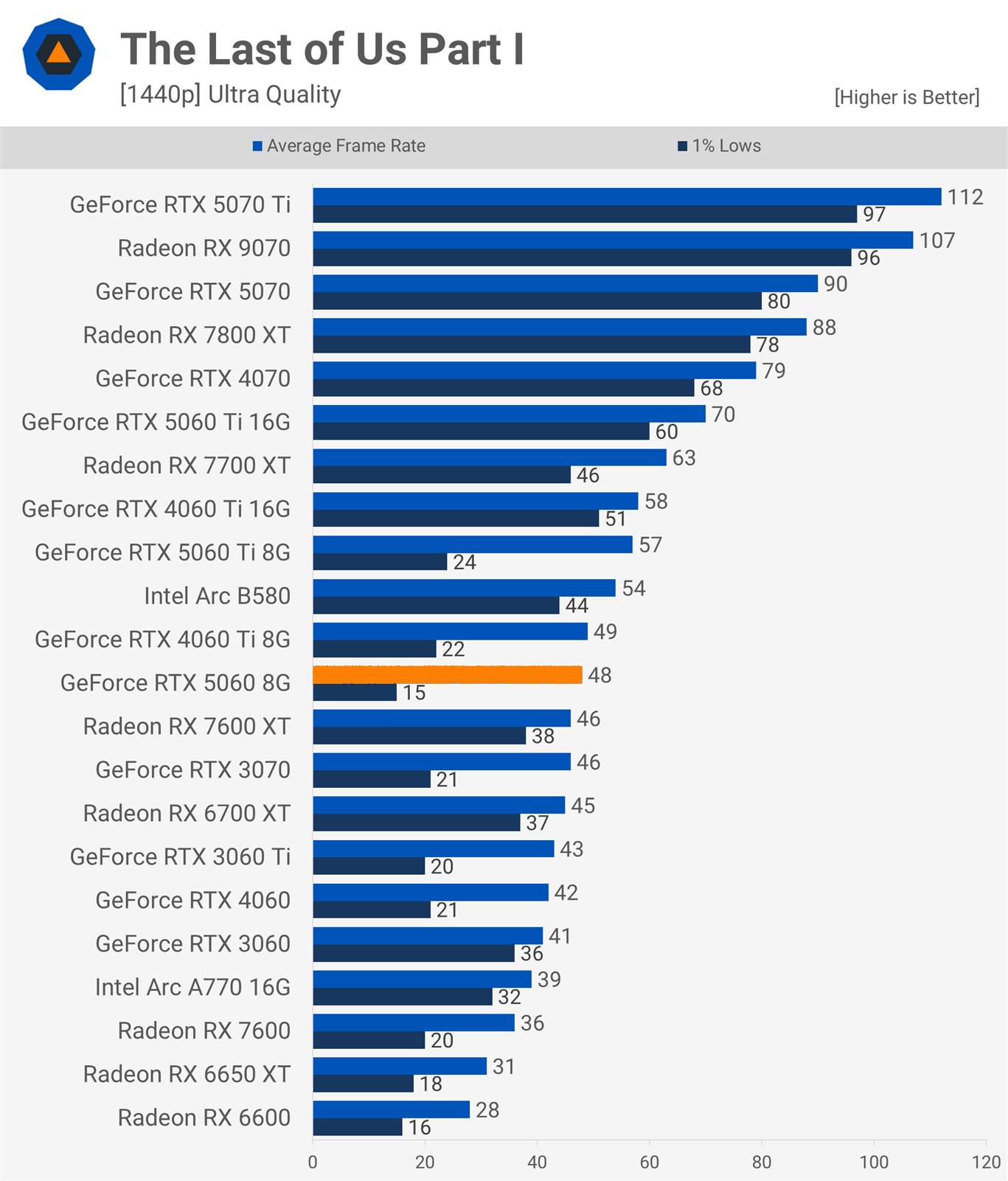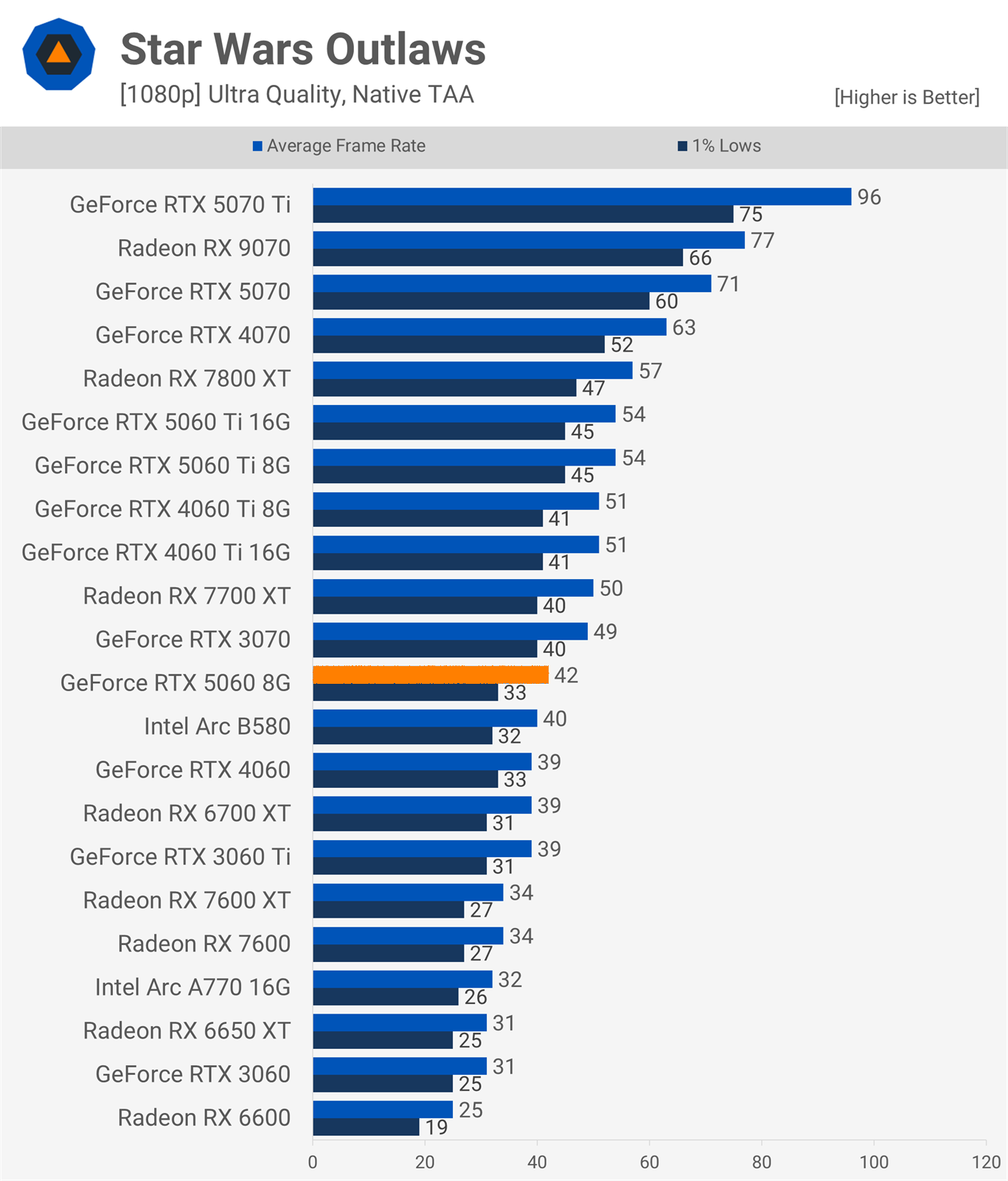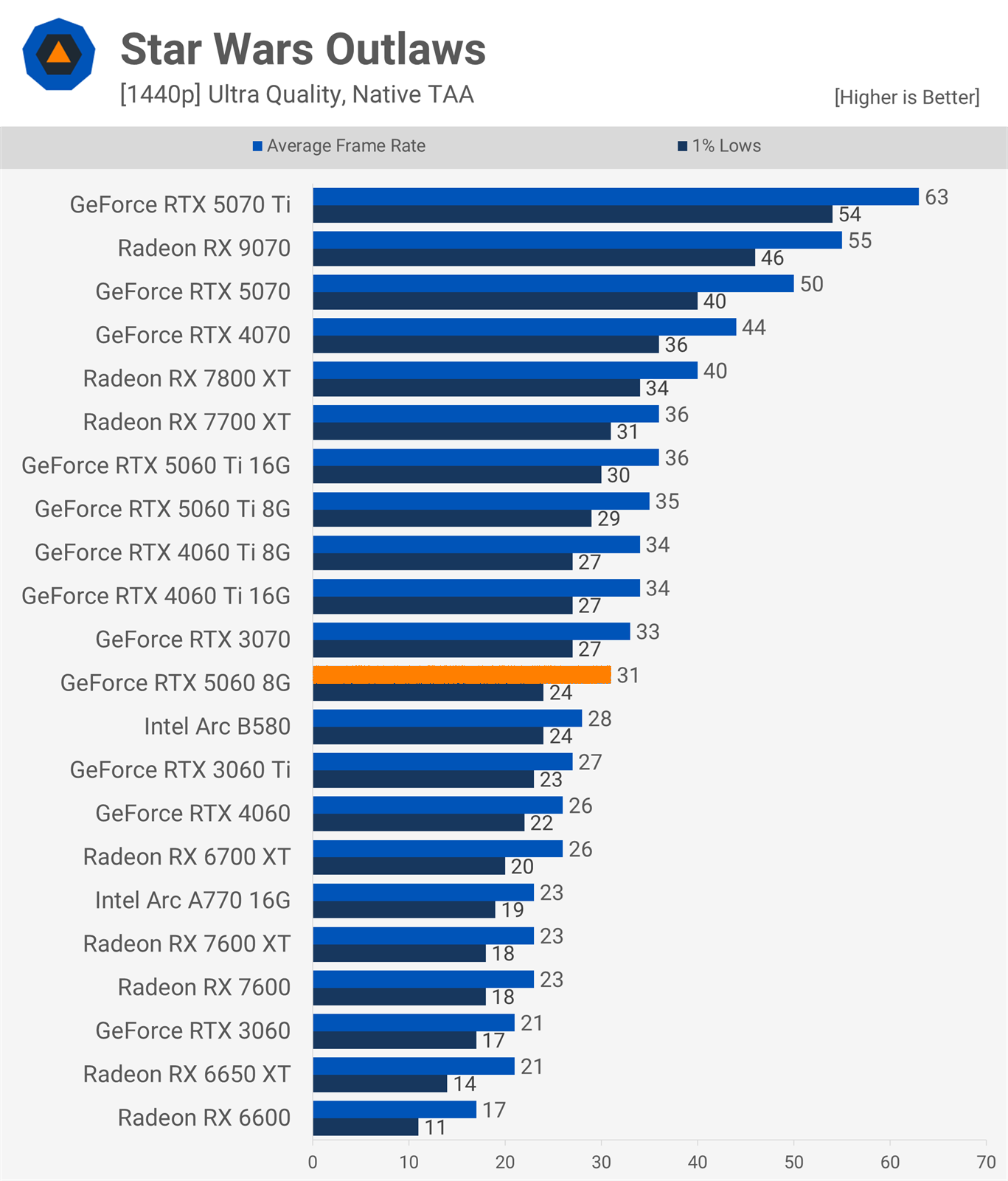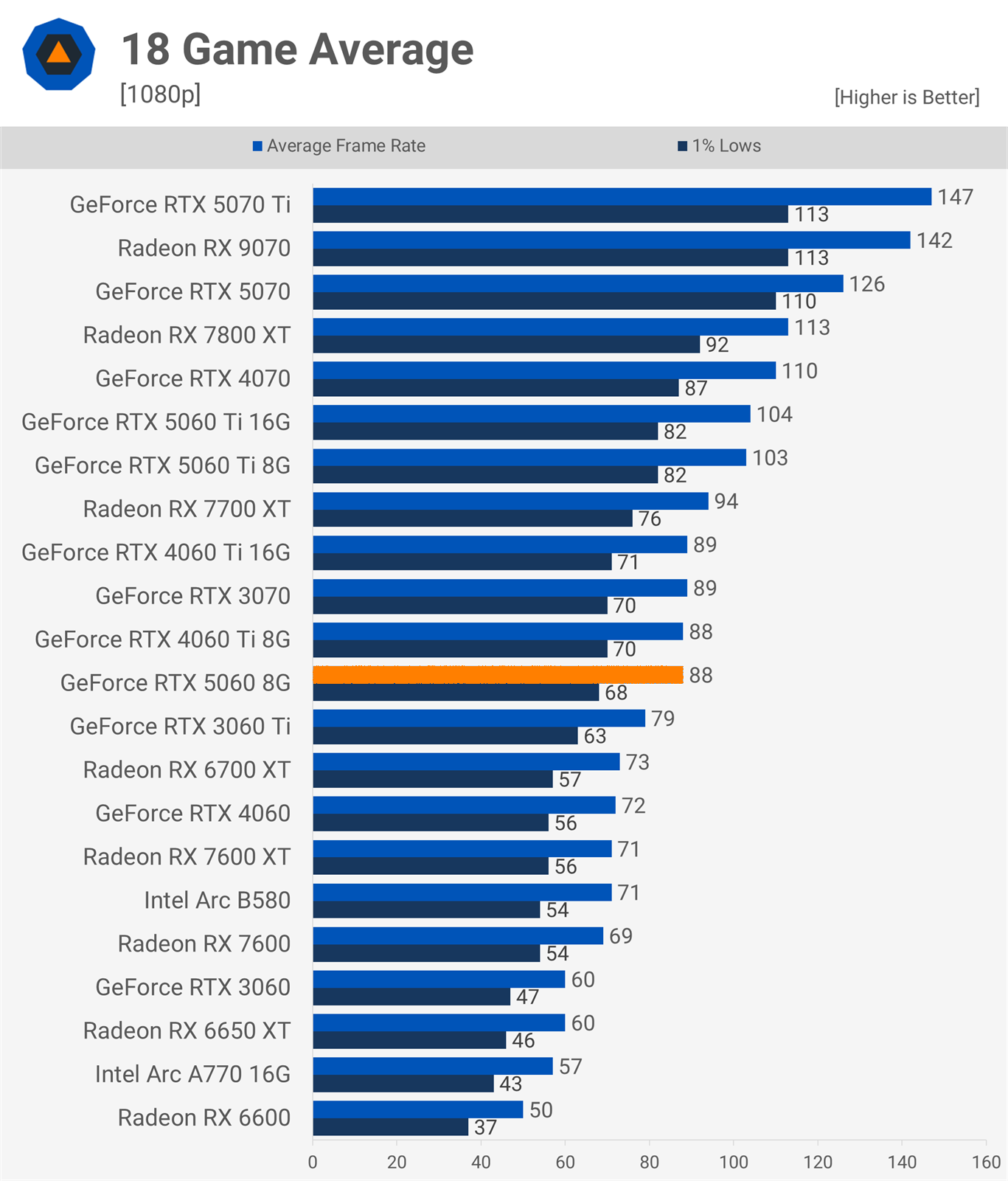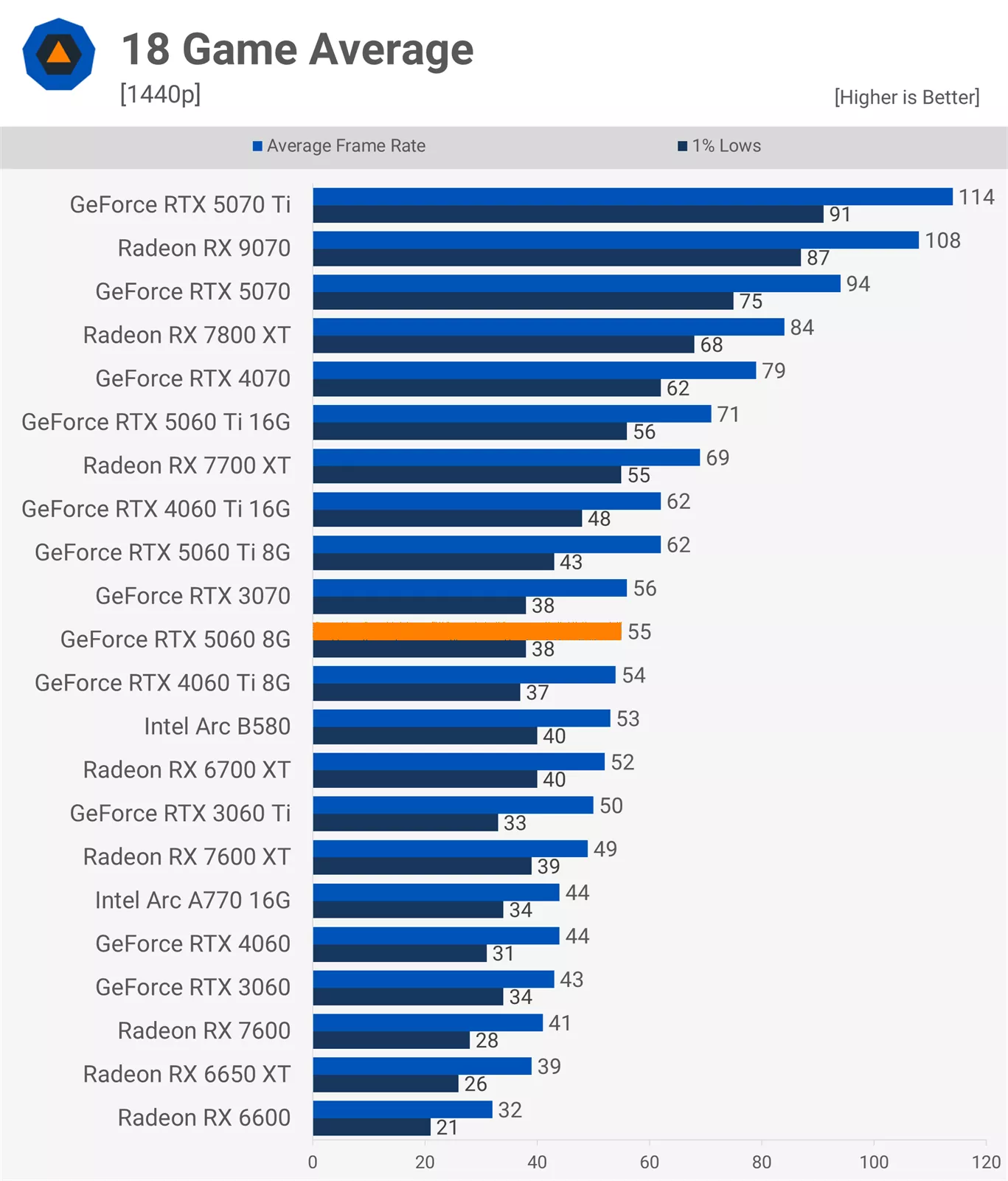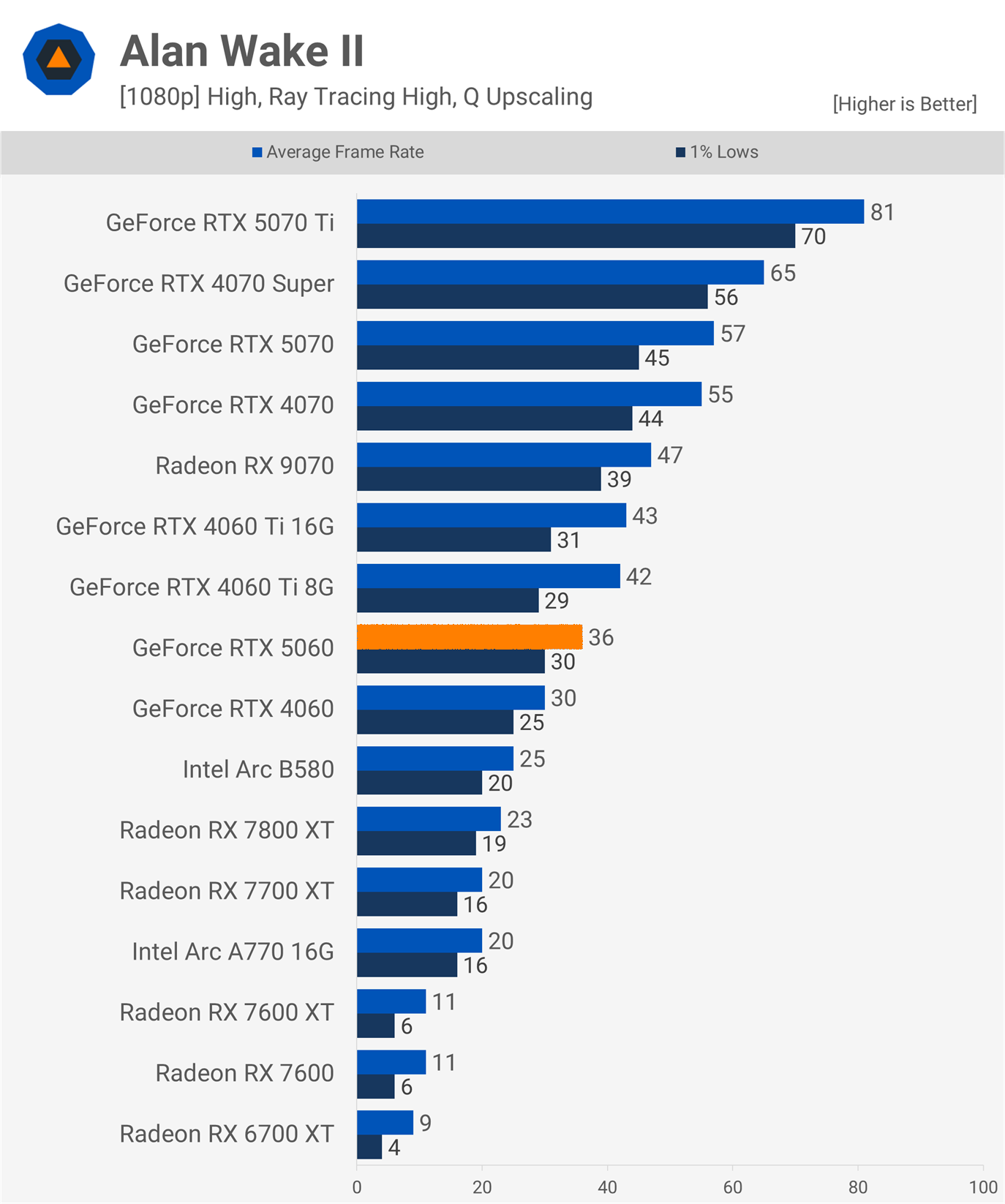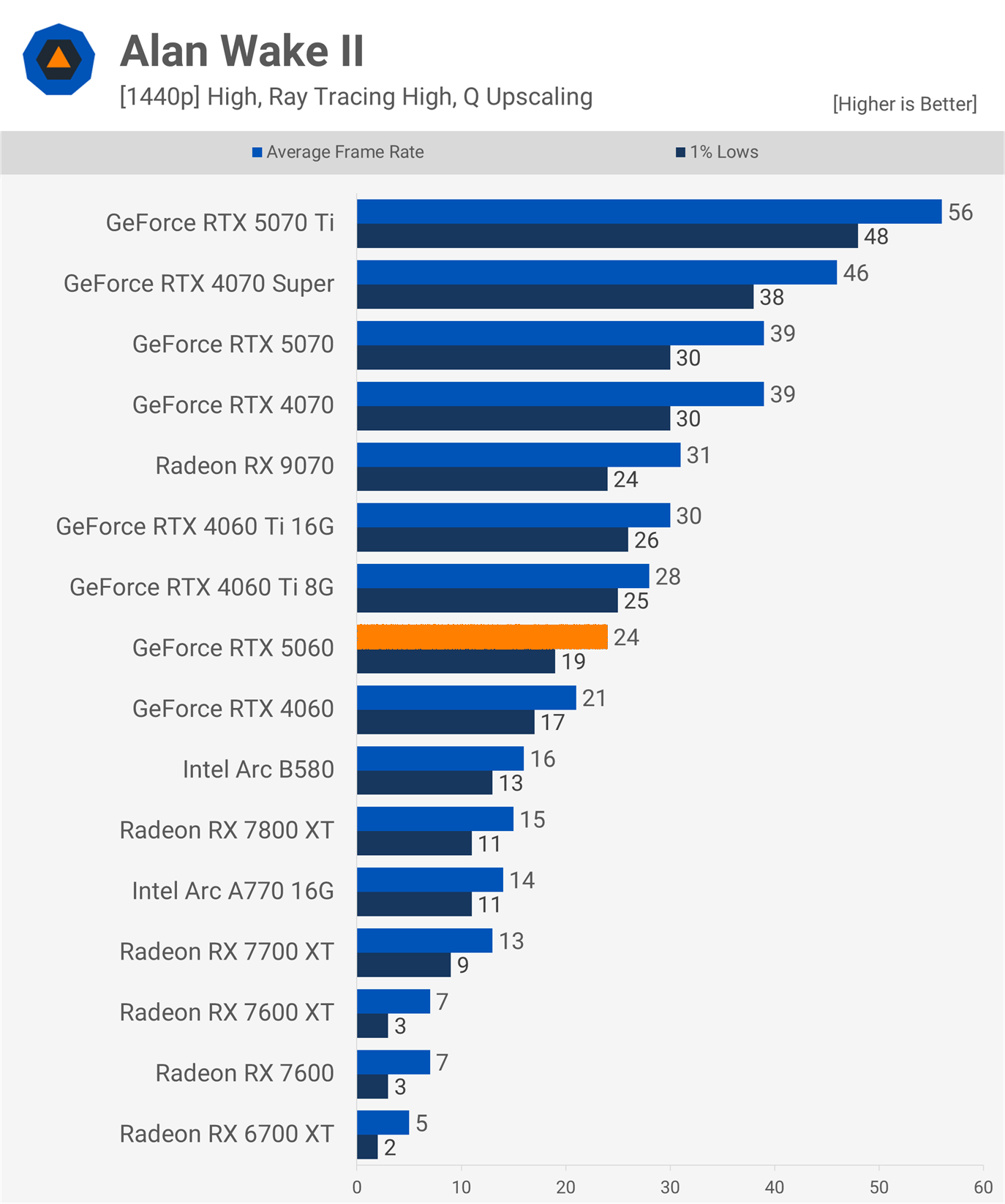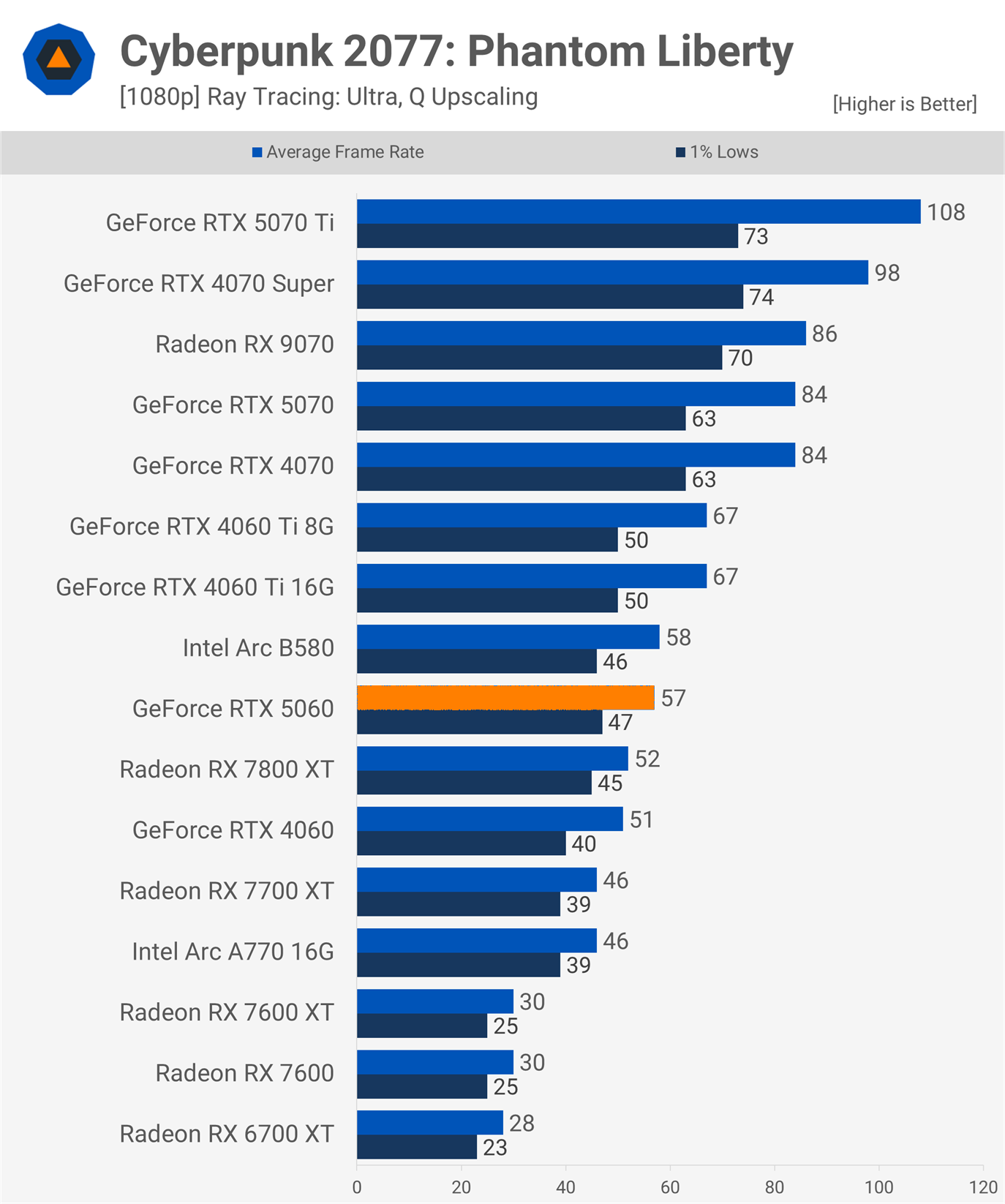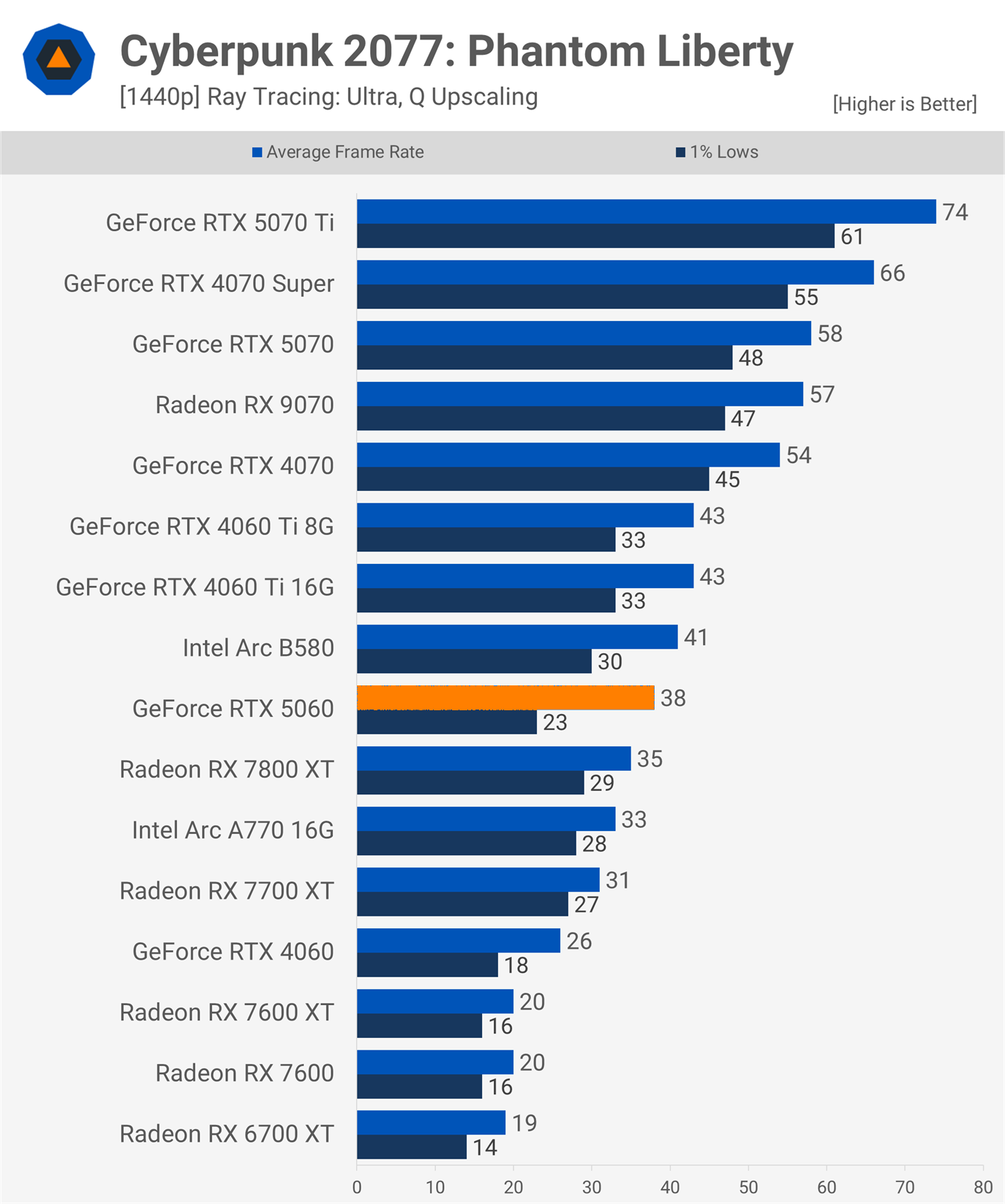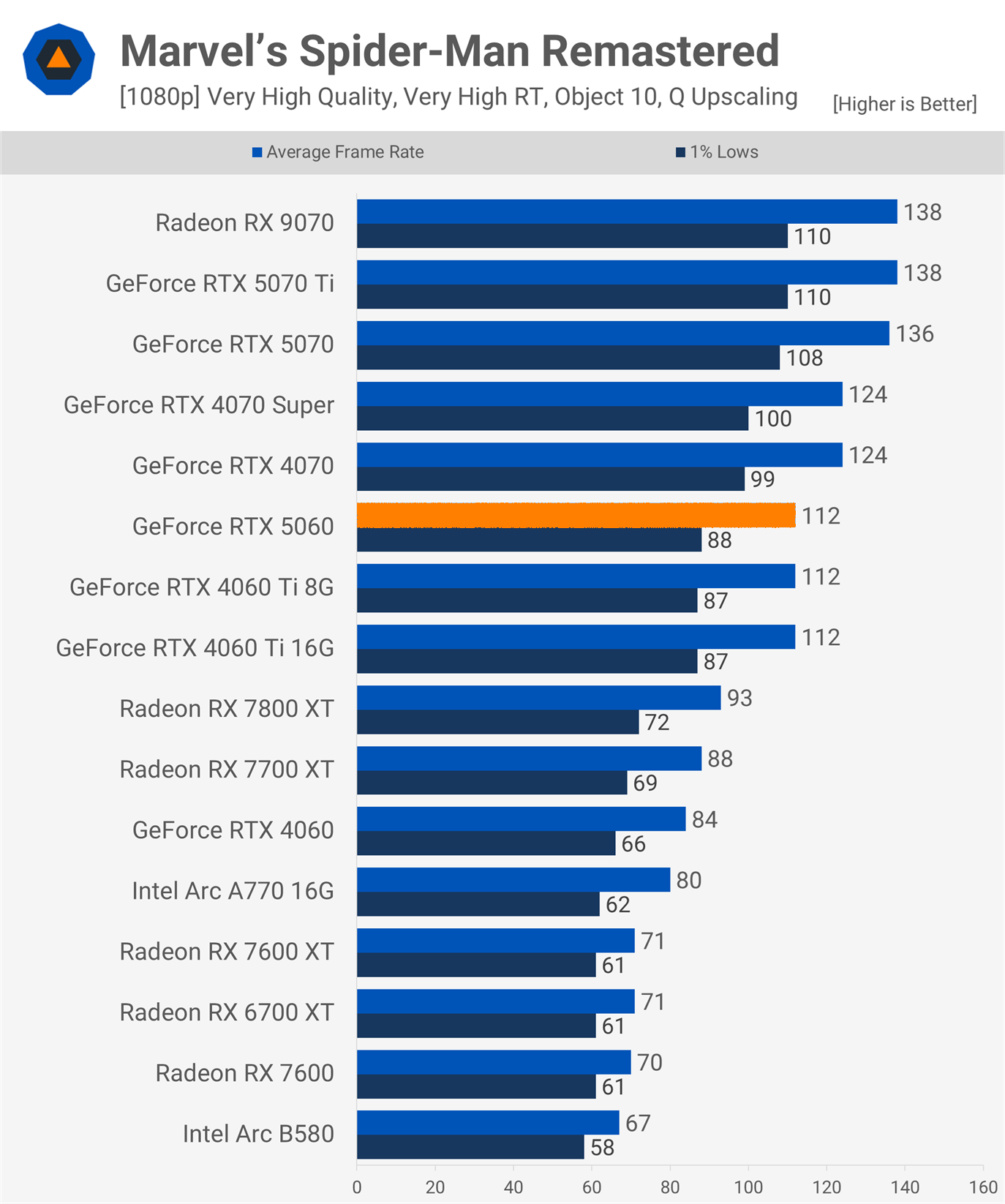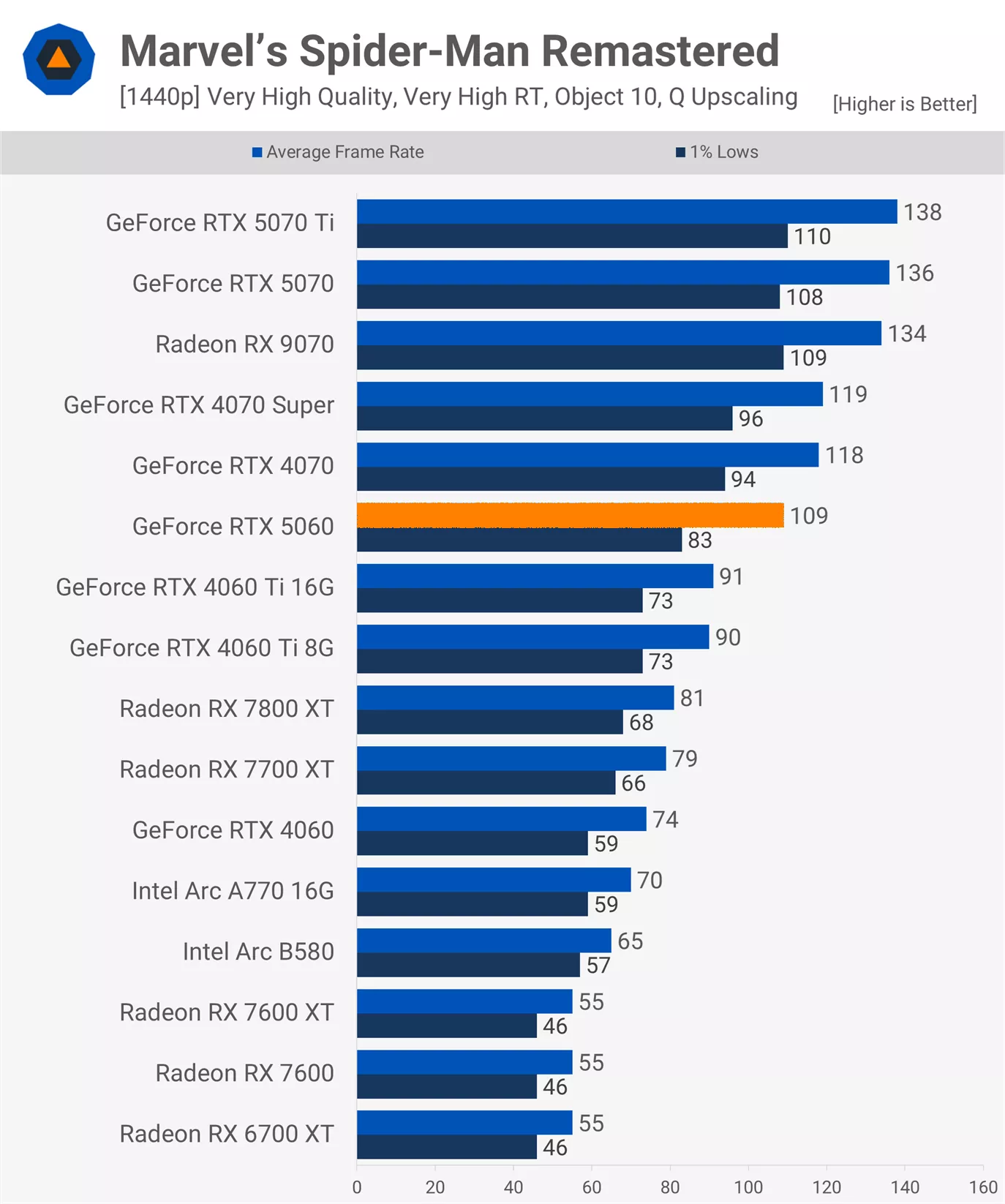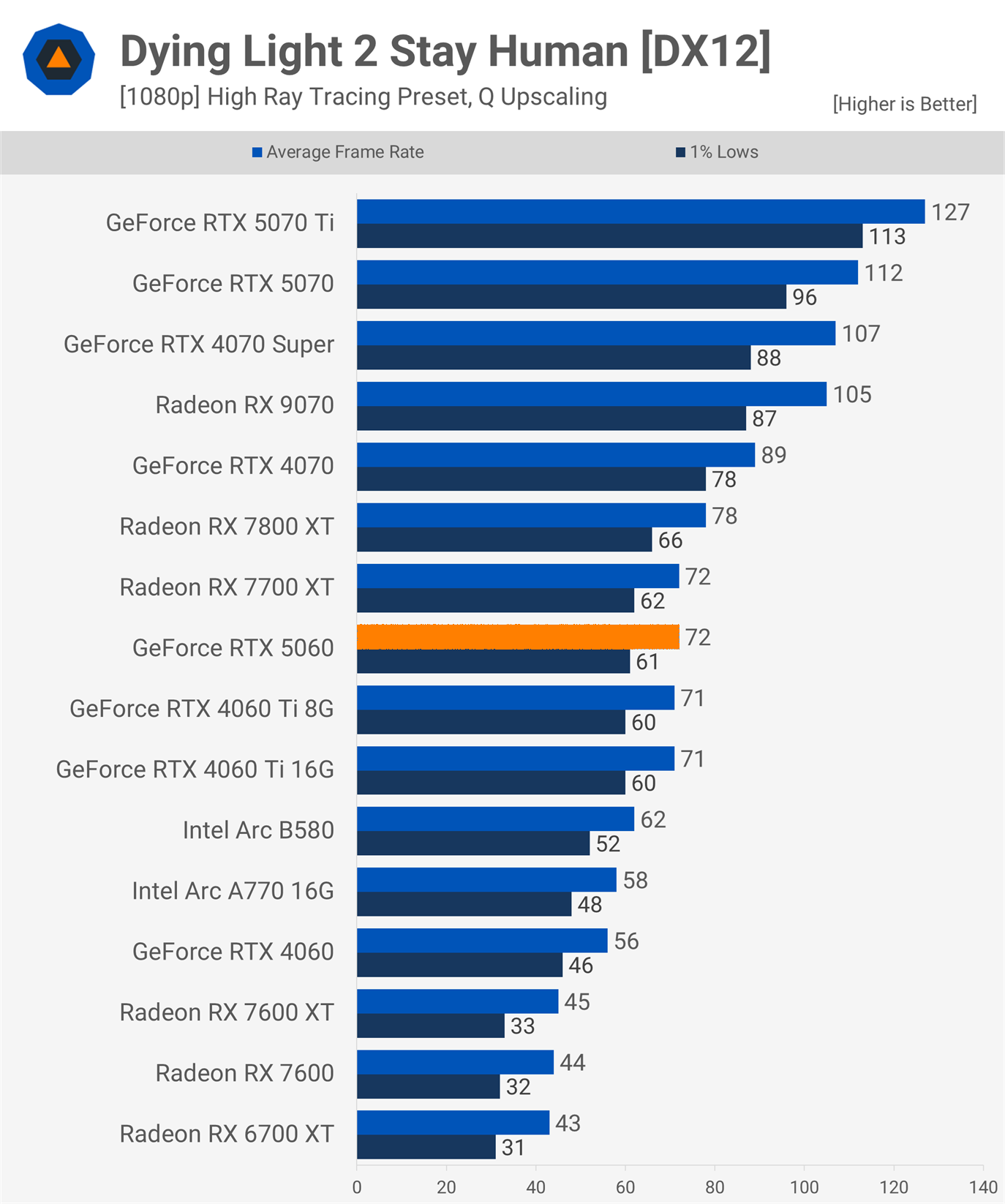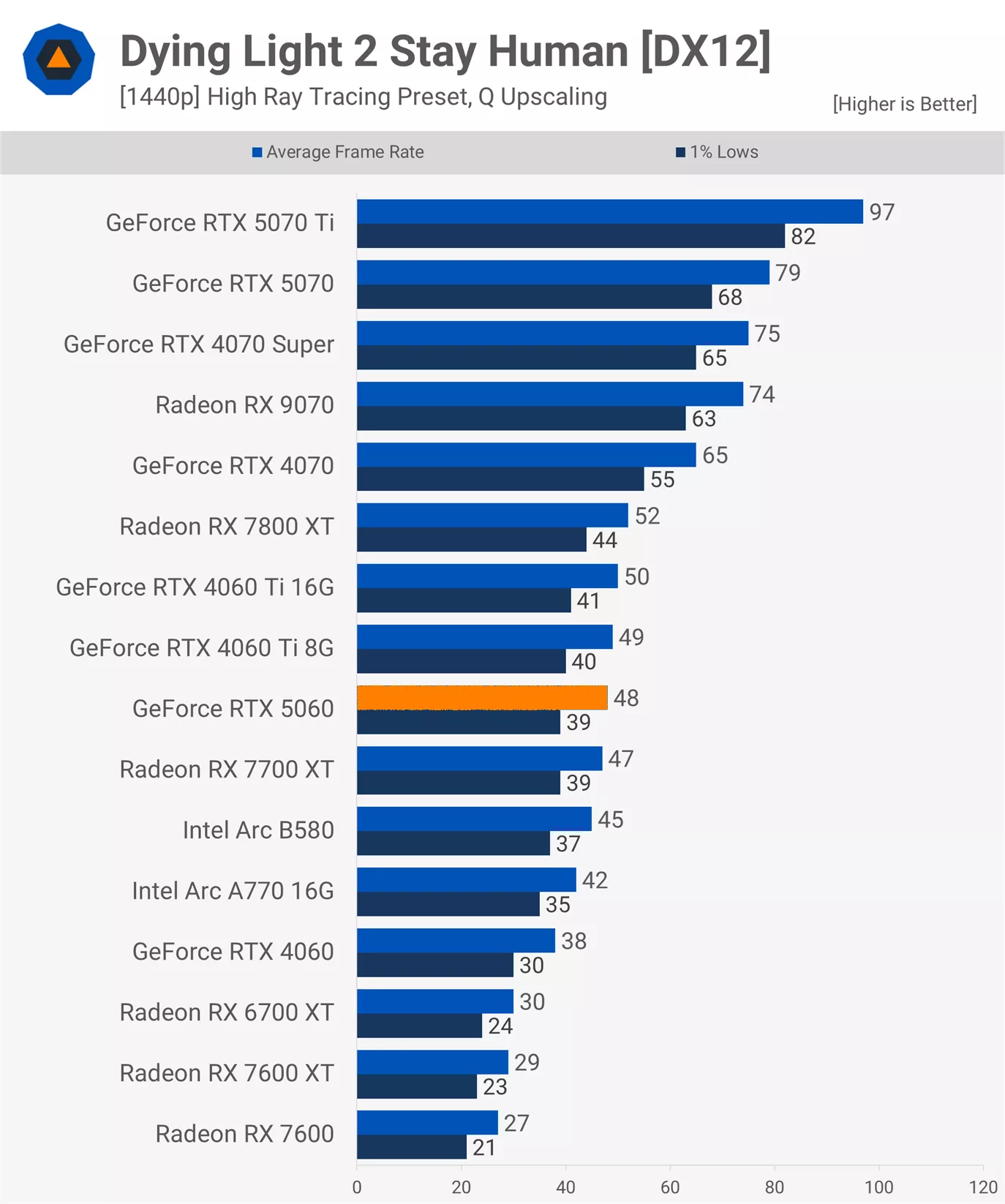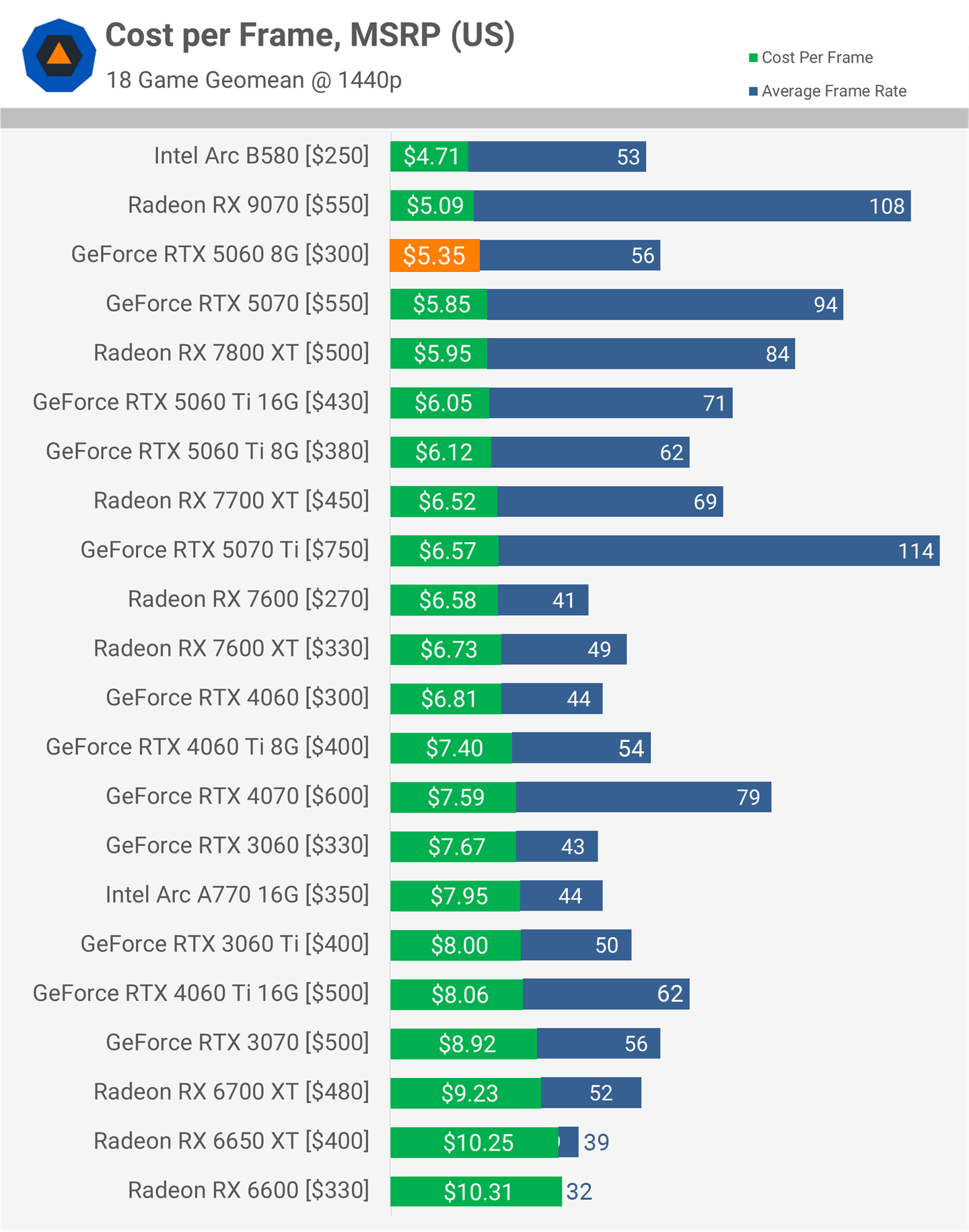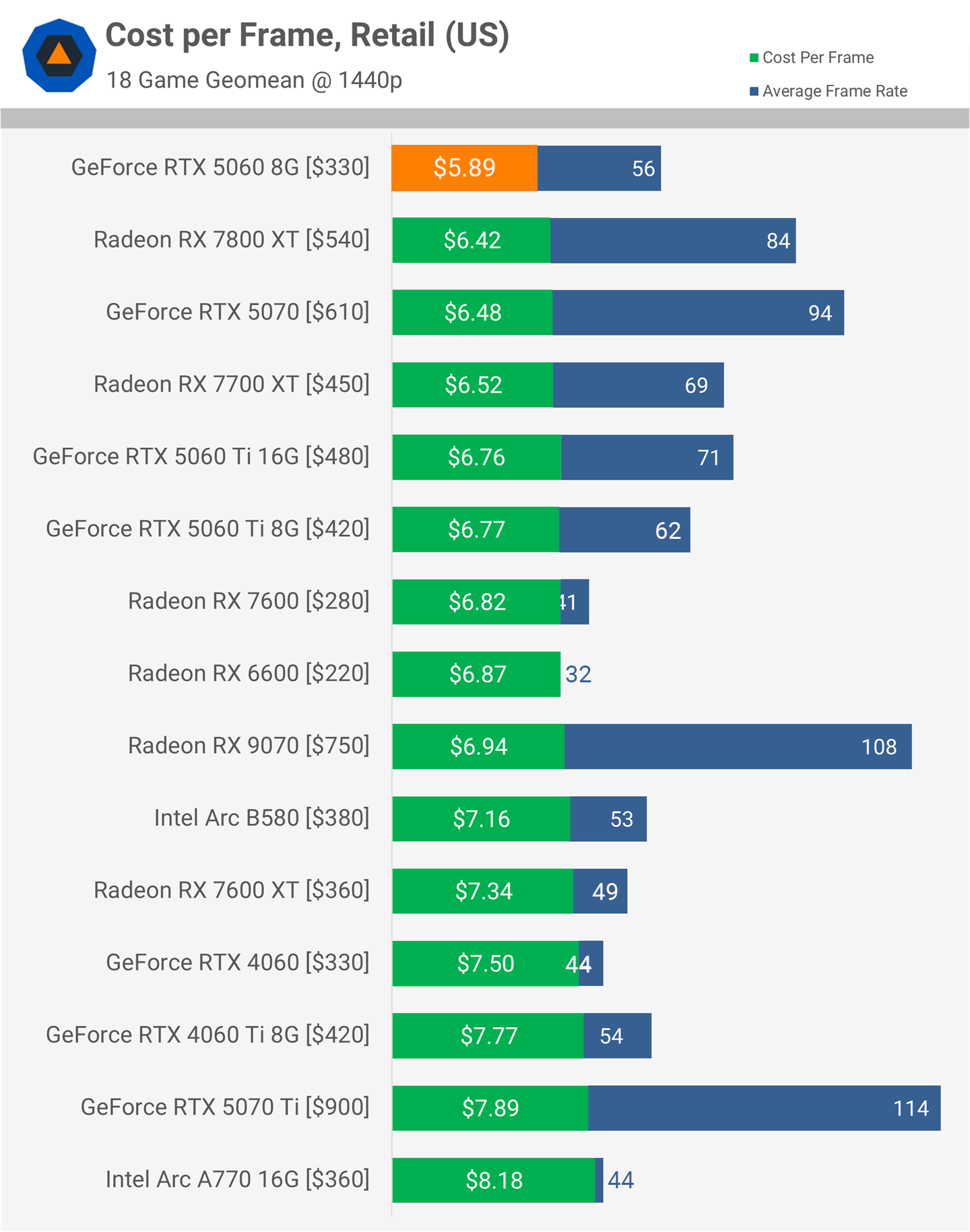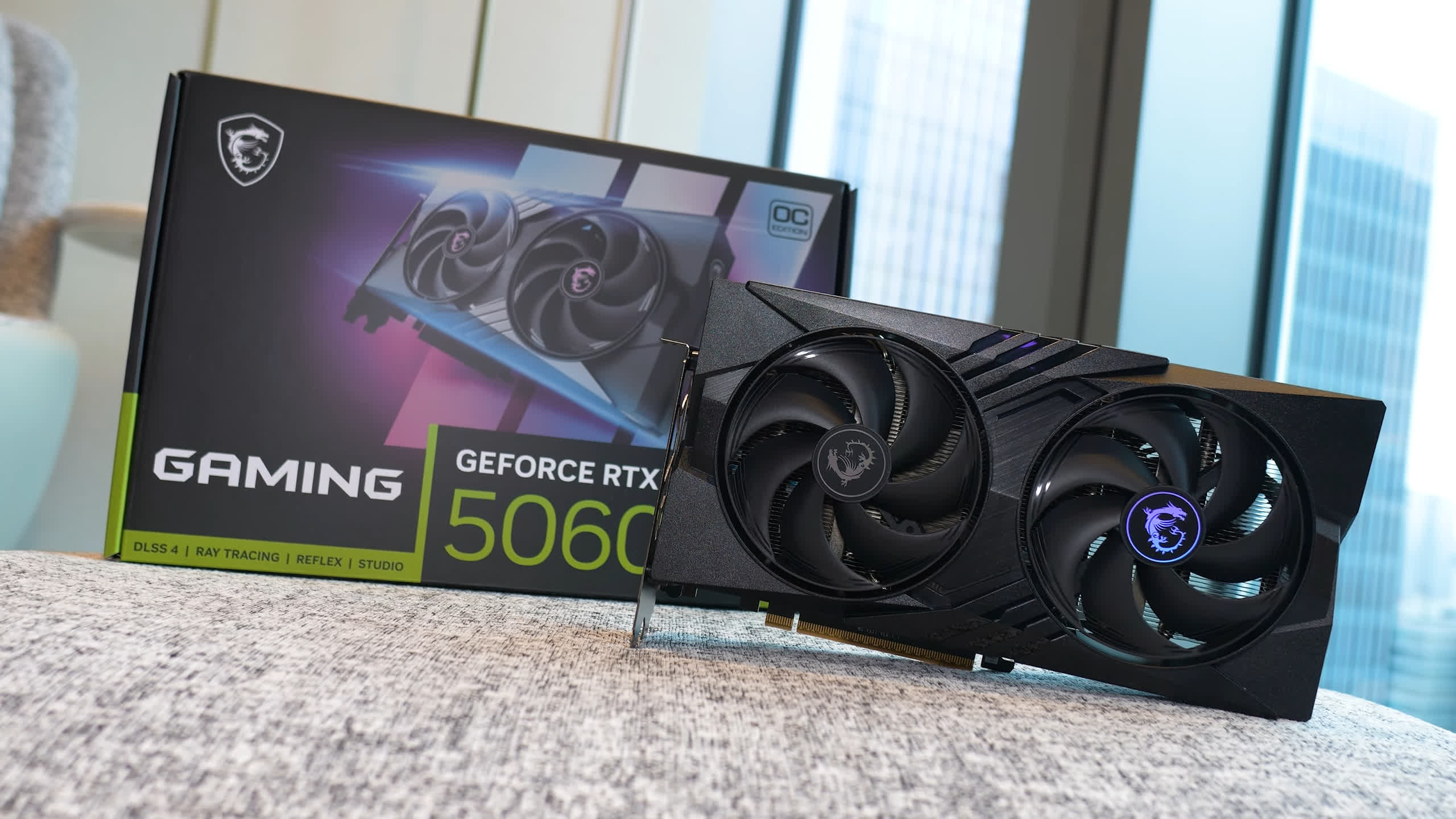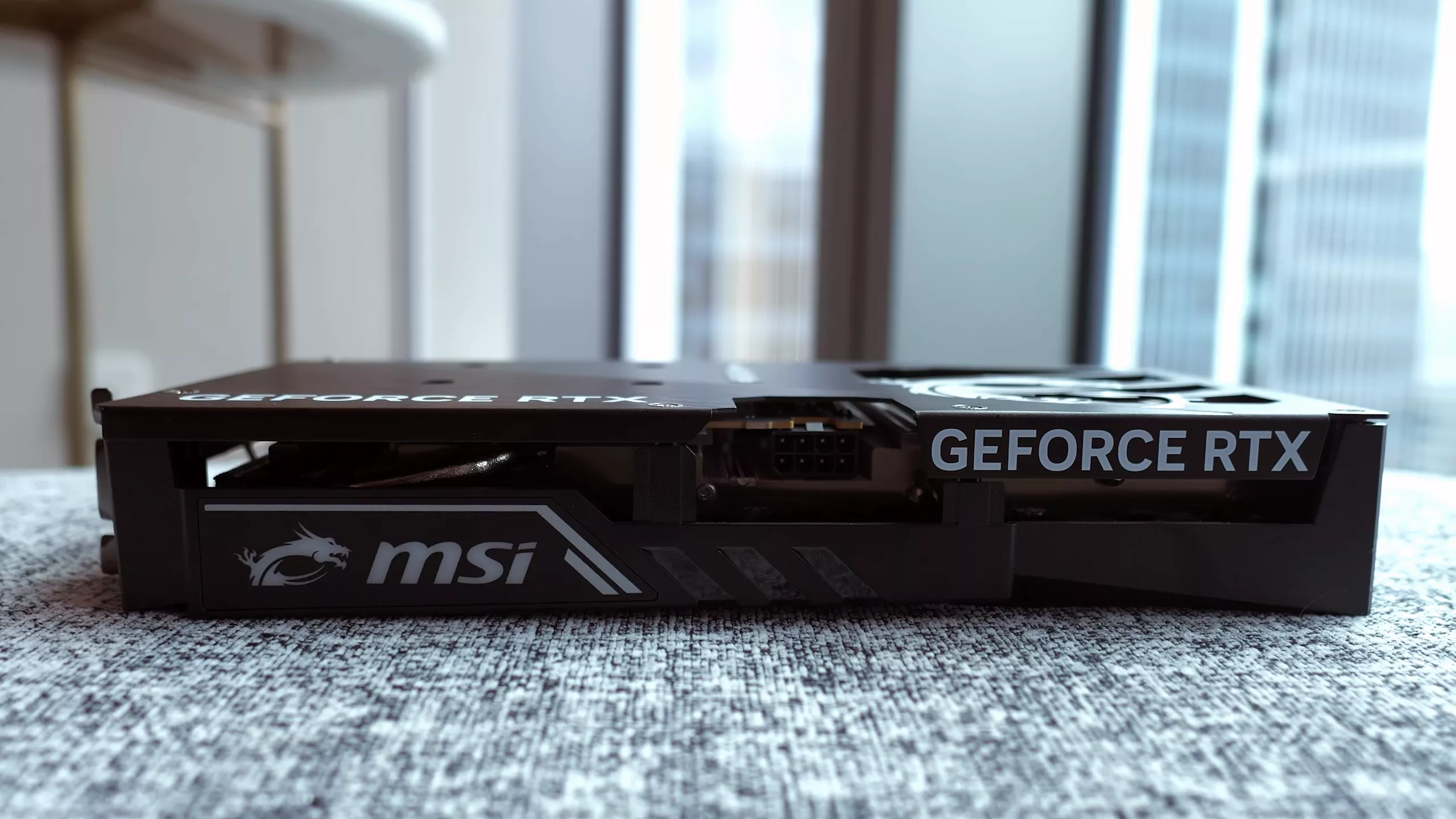The Nvidia RTX 5060 is based on the same GB206 silicon as the more expensive 5060 Ti series. This means the 181 mm² die contains 21.9 billion transistors – though not all are active in this model, as the core count has been reduced by 17%.
Still, the RTX 5060 features 25% more cores than the previous-gen 4060. Not only that, but thanks to the use of 28 Gbps GDDR7 memory, bandwidth has increased by 65% to 448 GB/s.
On paper, this is a $299 graphics card (MSRP) but we'll have to see what's the retail pricing looks like post-launch. This model is also limited to just 8 GB of VRAM, which is bad, however on the upside there is only one configuration available, making it far less of a trap for gamers compared to the more expensive 8GB RTX 5060 Ti.
| GeForce RTX 5060 |
GeForce RTX 4060 |
GeForce RTX 5060 Ti |
GeForce RTX 4060 Ti |
|
|---|---|---|---|---|
| Price MSRP | $300 | $300 | $380 / $430 | $400 / $500 |
| Release Date | May 2025 | June 2023 | April 2025 | May 2023 |
| Process | TSMC 4N | |||
| Die Size (mm2) | 181 mm² | 158.7 mm² | 181 mm² | 187.8 mm² |
| Core Config | 3840:120:48 | 3072:96:48 | 4608:144:48 | 4352:136:48 |
| L2 Cache (MB) | 32 MB | 24 MB | 32 MB | 32 MB |
| GPU Boost Clock | 2497 MHz | 2460 MHz | 2572 MHz | 2540 MHz |
| Memory Capacity | 8GB | 8GB | 8GB / 16GB | 8GB / 16GB |
| Memory Speed | 28 Gbps | 17 Gbps | 28 Gbps | 18 Gbps |
| Memory Type | GDDR7 | GDDR6 | GDDR7 | GDDR6 |
| Bus Type / Bandwidth |
128-bit, 448 GB/s |
128-bit, 272 GB/s |
128-bit, 448 GB/s |
128-bit, 288 GB/s |
| PCIe Bus Interface | PCIe 5.0 x8 | PCIe 4.0 x8 | PCIe 5.0 x8 | PCIe 4.0 x8 |
| Total Board Power | 145 W | 115 W | 180 W | 160 W |
Making the VRAM limitation even more problematic is the use of a PCIe 5.0 x8 bus interface. While not ideal even for PCIe 5.0-enabled systems, it becomes a major issue for those on older hardware, especially when restricted to PCIe 3.0. We can explore this further on a later extended review.
Believe it or not, we set up an AM5 test system in our hotel room while attending Computex 2025 in Taiwan. We're using a Ryzen 7 9800X3D processor we brought along, paired with a G.Skill Trident Z5 DDR5-6000 CL30 memory kit and our usual test SSD. A big thank you to MSI for providing the additional components needed to make this review possible.
It's been a challenging but worthwhile process to put this together – so let's dive into the data…
Benchmarks
Clair Obscur: Expedition 33
First up is Clair Obscur: Expedition 33, where the RTX 5060 averaged just 48 fps at 1080p. That's the same level of performance seen with the much older RTX 3060 Ti, making it only 17% faster than the RTX 4060.
Increasing the resolution using the Epic preset isn't really viable. The RTX 5060 simply isn't powerful enough and, with just 8 GB of VRAM, quickly runs out of memory. For example, the 5060 Ti 16 GB model is usable here, while the 8 GB version struggles significantly.
The Elder Scrolls IV: Oblivion Remastered
In Oblivion Remastered, the RTX 5060 delivered an average of 45 fps at 1080p, which is roughly on par with the RTX 4060 Ti and RTX 3070 – about 25% faster than the RTX 4060.
At 1440p, VRAM limitations show up again. While 34 fps is technically playable, 1% lows drop to just 18 fps, resulting in a very choppy experience.
Delta Force
Performance in Delta Force looks much better, with the RTX 5060 hitting 138 fps at 1080p. However, this is still in line with the RTX 3060 Ti and actually a bit slower than the RTX 4060 Ti.
At 1440p, the RTX 5060 again lands between the 3060 Ti and 3070, though this time its performance is closer to the 3070.
Stalker 2: Heart of Chornobyl
In Stalker 2, the RTX 5060 averaged 47 fps at 1080p – once again similar to the RTX 3060 Ti, and just a 9% improvement over the RTX 4060.
At 1440p, the 8 GB VRAM buffer becomes a major bottleneck, dropping average frame rates to just 6 fps. In this state, the game is essentially unplayable.
Counter-Strike 2
The RTX 5060 excels as an esports GPU, delivering strong performance in Counter-Strike 2 at 1080p using the medium preset. Impressively, it offers a 27% increase over the RTX 4060 and matches the performance of the older RTX 3070.
At 1440p, performance remained excellent, averaging 370 fps – slightly ahead of the Radeon RX 7700 XT.
Warhammer 40,000: Space Marine 2
Space Marine 2 ran very well at 1080p, with the RTX 5060 averaging 100 fps, providing a smooth experience and a 23% improvement over the RTX 4060.
At 1440p, performance improved by a massive 33% over the 4060, coming very close to RX 7700 XT levels.
Star Wars Jedi: Survivor
Star Wars Jedi: Survivor also ran smoothly, with 95 fps on average at 1080p. This level of performance puts the RTX 5060 in the same range as the RTX 4060 Ti and RTX 3070.
At 1440p, the trend continues: 57 fps on average matches 4060 Ti and 3070 levels and represents a 30% uplift over the RTX 4060 – an impressive result.
Call of Duty: Black Ops 6
Call of Duty: Black Ops 6 saw the RTX 5060 render 75 fps at 1080p, which was only a 10% uplift over the 4060 and 7% slower than the RTX 3070 – not a great result overall.
It's a similar story at 1440p, where performance is essentially on par with the RTX 3060 Ti. That's a disappointing outcome given how much time has passed since that GPU's release.
A Plague Tale: Requiem
In A Plague Tale: Requiem at 1080p, the RTX 5060 delivered just a 5% improvement over the RTX 3070, making it slightly slower than the 7700 XT. However, it was a significant 36% faster than the RTX 4060.
At 1440p, it continued to outperform the 4060 with a 33% advantage, although it only managed to match the performance of the RTX 3070 and 4060 Ti.
Starfield
Starfield performance was even weaker. At 1080p, the RTX 5060 matched the RTX 3060 Ti with just 55 fps on average.
At 1440p, the margin remained narrow, with the RTX 5060 averaging 44 fps – just 5% faster than the 3060 Ti.
Cyberpunk 2077: Phantom Liberty
Performance in Cyberpunk 2077 at 1080p was solid. The RTX 5060 averaged 100 fps, putting it on par with the 4060 Ti and 28% ahead of the RTX 4060.
At 1440p, it maintained strong performance with 66 fps on average, again delivering results similar to the 4060 Ti and RTX 3070 – 35% faster than the 4060 in this case.
God of War Ragnarök
The RTX 5060 delivered surprisingly strong results in God of War Ragnarök at 1080p, averaging 128 fps – an impressive 45% improvement over the RTX 4060.
That margin was reduced at 1440p, but the 5060 still came in 32% faster than the 4060, again delivering performance comparable to the RTX 3070 and 4060 Ti.
Dying Light 2 Stay Human
In Dying Light 2, the RTX 5060 effectively matched the RTX 3070 and 4060 Ti at 1080p.
At 1440p, the story remained consistent – though here, the Arc B580 also entered the performance mix.
Dragon Age: The Veilguard
Interestingly, Dragon Age: The Veilguard proved more difficult. At 1080p, the RTX 5060 rendered just 68 fps, making it only 11% faster than the RTX 4060 and notably slower than both the RTX 3070 and 4060 Ti.
At 1440p, the performance gap narrowed, with the 5060 aligning more closely with the RTX 3070 and 4060 Ti, though average frame rates dropped to 49 fps – not exactly impressive.
Marvel's Spider-Man Remastered
Spider-Man Remastered posed no challenge for the RTX 5060 at 1080p. It averaged 159 fps, narrowly edging out the 4060 Ti and RTX 3070, and delivering a 25% uplift over the RTX 4060.
At 1440p, performance remained strong with 110 fps on average. Relative performance was typical, closely matching the Arc B580, 4060 Ti, and RTX 3070.
Hogwarts Legacy
Performance in Hogwarts Legacy at 1080p was also impressive. The RTX 5060 averaged 101 fps – slightly faster than the RTX 3070, significantly ahead of the 4060 Ti, and 44% faster than the RTX 4060. This game is very memory-intensive, so the high-speed GDDR7 memory is well utilized here.
At 1440p, a different bottleneck appears. The RTX 5060 only matched the 4060 Ti, resulting in a 13% performance uplift over the 4060.
The Last of Us Part I
In The Last of Us Part I, the RTX 5060 delivered 85 fps at 1080p, putting it on par with the 4060 Ti and 25% faster than the RTX 4060.
However, at 1440p, performance fell apart. With just 8 GB of VRAM, the 5060 couldn't maintain consistent frame times using ultra-quality settings.
Star Wars Outlaws
Finally, in Star Wars Outlaws, the RTX 5060 struggled. At 1080p, it rendered only 42 fps – a mere 8% improvement over the RTX 4060.
At 1440p, frame rates dropped further to 31 fps, making it 19% faster than the 4060 but still delivering very weak performance overall.
Performance Summary
1080p
Across the 18 games tested, the RTX 5060 matched the performance of the RTX 4060 Ti and RTX 3070, while coming in 6% slower than the 7700 XT. It was also 22% faster than the RTX 4060, which aligns closely with Nvidia's official claims.
1440p
At 1440p, we saw several examples where 8 GB GPUs began to fall apart. In some cases, performance appeared acceptable, but the visual quality suffered due to missing textures that couldn't fit into local video memory.
Overall, the RTX 5060 remained on par with the RTX 3070 and 4060 Ti, though it was just 6% faster than Intel's Arc B580 and 27% faster than the RTX 4060.
Ray Tracing Performance
RT - Alan Wake II
As expected, achieving a high-end ray tracing experience is difficult – if not impossible – with the RTX 5060. The GPU simply doesn't have enough power, and its 8 GB of VRAM is insufficient for ray tracing in modern titles.
For example, in Alan Wake II at 1080p with DLSS Quality enabled, the RTX 5060 averaged just 36 fps. That made it 20% faster than the RTX 4060, but 14% slower than the 4060 Ti.
Those hoping to enable ray tracing at 1440p will be disappointed – it's simply not viable on this GPU.
RT - Cyberpunk 2077
Thanks to DLSS, it's possible to approach 60 fps at 1080p in Cyberpunk 2077 using the Ultra RT preset. However, since this relies on upscaling, it's not true 1080p rendering. Performance is comparable to the Arc B580 – not a particularly strong result.
At 1440p, ray tracing is off the table. We also encountered VRAM limitations during our brief testing.
RT - Spider-Man Remastered
Marvel's Spider-Man Remastered is a well-optimized title, and even with ray tracing maxed out, the RTX 5060 managed an impressive 112 fps on average at 1080p – similar to the 4060 Ti.
At 1440p, the RTX 5060 performed even better, averaging 109 fps and pulling well ahead of the 4060 Ti. That's a solid result, nearly matching the RTX 4070. Still, you'd typically expect a product labeled "5060" to at least match the previous-generation GPU positioned one tier higher.
RT - Dying Light 2
At upscaled 1080p with the high ray tracing preset, Dying Light 2 ran at 72 fps on the RTX 5060 – matching the 7700 XT and 4060 Ti. This is usable performance, though not outstanding, despite being almost 30% faster than the RTX 4060.
At 1440p, the RTX 5060 struggled more, delivering just 48 fps on average. This result was still similar to the 7700 XT and 4060 Ti.
Cost per Frame
MSRP
We know MSRP isn't always reflective of reality, especially at launch, but it's still useful for establishing a baseline. If all GPUs were sold at their suggested prices, the Arc B580 would offer the best value, followed by the RX 9070, and then the RTX 5060.
At MSRP, the 5060 comes in at a cost per frame of $5.35 – a 21% improvement over the RTX 4060 and a 30% improvement over the RTX 3060. That sounds solid, or at least it would be if the card had more VRAM. We'll come back to that shortly. For now, let's take a look at real retail pricing.
Real Retail Pricing (USA)
At the time of writing this review, the RTX 5060 was available and in stock on Newegg for $330 – about 10% over MSRP. In the current market, that makes it relatively decent value, assuming you ignore the elephant in the room: the 8 GB VRAM buffer.
Even when factoring in the poor results seen in some VRAM-limited games, particularly in titles where missing textures or inconsistent frame times become an issue, the RTX 5060 still manages to be 8% better value than the 7800 XT.
That's not a strong showing considering the Radeon GPU comes with 16 GB of VRAM. Compared to the outgoing RX 7600, it's 14% better value, and 21% better value than remaining RTX 4060 stock.
So, given today's market conditions, the RTX 5060 offers decent value for buyers looking to purchase a brand-new GPU. But with just 8 GB of VRAM, it's not a product we can recommend at that price.
It's Not What You Think
So there you have it. On the surface, the RTX 5060 appears to stack up fairly well. If you don't look too closely, you might even call it good value. But deeper analysis reveals a troubled product that will almost certainly age incredibly poorly.
As we've clearly established by now, 8 GB of VRAM is simply not enough – and in 2025, it should not exist on any GPU priced above $200. As an esports card, it holds up reasonably well, though if that's your target use case, we'd suggest exploring the second-hand market instead.
It's frustrating how good the RTX 5060 could have been. Even with just 12 GB of VRAM, we might have been able to tentatively recommend it at its current price. With 16 GB, it could have been a genuinely solid product.
As it stands, the RTX 5060 is effectively a discounted RTX 4060 Ti – offering about 25% savings. That might sound appealing, but nearly two years after the 4060 Ti's release, it's hardly exciting. Looking further back, the 5060 essentially offers RTX 3070-like performance at a 40% discount – but nearly five years have passed since Ampere launched.
In our opinion, Nvidia had a clear opportunity to deliver a meaningful upgrade here. Instead, they've recycled the same class of GPU for five years, offering incremental discounts with each release.
The real challenge for Nvidia will be the incoming Radeon RX 9060 XT series. If AMD's numbers prove accurate, the RTX 5060 won't be worth considering – it's dead on arrival, at least for buyers who follow real, independent reviews. On that note, Nvidia has handled this launch very poorly. It's been a PR disaster. Ironically, Nvidia's marketing may be more effective than AMD's at convincing GeForce owners to switch to Radeon. In fact, this might be the only way that shift was ever going to happen.
That's going to wrap up our review of the RTX 5060. We debated calling it a preview rather than a full review – but claiming an "RTX 5060 preview" feels like a bit of a self-own at this point. So let's call it a quick review.
We'll cover more details, including ray tracing performance, power consumption, and overclocking, once we're back from Computex. Needless to say, Steve has outdone himself to deliver a comprehensive and honest look at this GPU under the circumstances. If you've found it helpful, we appreciate your support.
